
AUSTRALIAN CURRICULUM OXFORD HA SS 7 HUMANITIES AND SOCIAL SCIENCES SERIES CONSULTANTS: JULIE DAVIS KAY BISHOP MARK EASTON MAGGY SALDAIS SARAH COLEMAN VLADIMIR DUMOVIC KATRINA DAVEY GERALDINE CARRODUS CHRISTIAN MACHAR SECOND EDITION Sample chapter This sample chapter is provided in draft format for inspection purposes. To access a sample of the digital resources that support the series, visit: oup.com.au/ac-hums-info
ii OXFORD HUMANITIES AND SOCIAL SCIENCES 7 AUSTRALIAN CURRICULUM OXFORD UNIVERSITY PRESS No part of this publication may be reproduced, stored in a retrieval system or transmitted in any form or by any means. DRAFT
Contents by skill Oxford Humanities
PART 1 Geography
Concepts and skills
Chapter 1
The geography toolkit 4
1A What are the geographical concepts?

1.1 Geographical concepts 6
1B What are the geographical skills?
1.2 Geographical skills 12
1.3 Questioning and researching using geographical information
1.4 Interpreting and analysing geographical data and information
1.5 Concluding and decision-making 1.6 Communicating 16
Water in the world
Chapter 2
Water as a resource 36
2A How is water an environmental resource?
2.1 Environmental resources: an overview 38 Where water comes from 40 2.3 Water as an available resource 2.4 Water as a potential resource
2A Skills in context: Perth’s water supply 46
2B How does water connect and affect places?
2.5 Water connects places 48 2.6 Water changes places 50 Water as an environmental resource
2.8 Water as an economic resource Water as a social resource

2.10 Water as a cultural resource
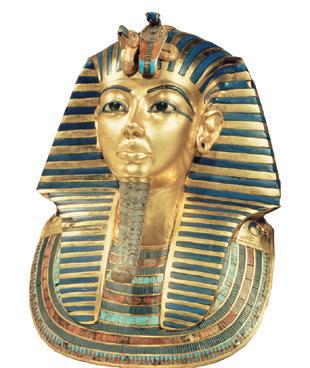
2B Skills in context: The Three Gorges Dam 60
2C How much water do we have in the world?
2.11 Water in Australia 62
2.12 Australia: a land of drought and rain 64 2.13 Water in the world 66
2C Skills in context: Brisbane flood 2022 68 review system
viii Introducing
and Social Sciences 7–10 x
...........................
..........................................................
13
14
15
............................
2.2
42
44
2.7
52
54 2.9
................................................... 56
58
.....................................
Chapter
70 CO NT E TS T CONTENTS iiiOXFORD UNIVERSITY PRESS No part of this publication may be reproduced, stored in a retrieval
or transmitted in any form or by any means. DRAFT
Chapter 3
Valuing and managing water 72
3A How do we manage and value water?
3.1 The value of water 74
3.2 The value of water for growing food 76
3.3 Competition for water supplies 78
3.4 The challenges of managing water 80
3A Skills in context: The disappearing lake 84
3B How can we manage water scarcity?
3.5 What is water scarcity? 86 3.6 The causes of water scarcity 88
3.7 Managing water scarcity in Melbourne 90
3B Skills in context: An unlikely source of water.........................92
3C How can we manage tropical cyclones as a water hazard?
3.8 Why tropical cyclones occur 94
3.9 Where tropical cyclones occur 96
3.10 The impacts of tropical cyclones 98
3.11 Preparing for tropical cyclones 102
3C Skills in context: Cyclone Yasi 104 Chapter review 106
Place and liveability
Chapter 4
Living in Australia 108
4A Where do Australians live and why?
4.1 Why we live where we do 110 4.2 Where early Aboriginal peoples lived 112
4.3 Where Australians live now 116
4.4 Living in large cities 118
4.5 Living in rural areas 122
4.6 Living in coastal areas 124
4.7 Living in remote areas 127
4A Skills in context: Melbourne’s skating survey 130
4B How do people connect to places?
4.8 Living in communities 132
4.9 First Nations communities 134
4.10 Building safe communities 138
4B Skills in context: Living in an isolated community 140
Chapter review 142
Chapter 5
Liveable cities 144
5A What makes a city liveable?
5.1 How we measure liveability 146
5.2 Clean water and sanitation 150
5.3 Environmental quality 152
5.4 Natural landscape 154
5.5 Infrastructure 156
5.6 Safety and stability 158
5.7 Access to health care and education 160
5A Skills in context: Liveability with disability 162
5B Where are the world’s most and least liveable cities?
5.8 The world’s most liveable cities 164
5.9 Australia’s liveable cities 166
5.10 The world’s least liveable cities 168
5.11 Damascus: the least liveable city 170
5B Skills in context: Local area liveability 174
5C How can we make cities more liveable?
5.12 Threats to liveability 176
5.13 Strategies to improve liveability: Sustainability 180
5.14 Strategies to improve liveability for young people 182
5C Skills in context: Improving liveability in your local area 184 Chapter review 186
PART 2
History Concepts and skills
Chapter 6 The history toolkit.............................. 190
6A What are the historical concepts? 6.1 Historical concepts 192
6B What are the historical skills?
6.2 Historical skills 194 6.3 Questioning and researching 195 6.4 Using historical sources 198 6.5 Historical perspectives and interpretations 200 6.6 Communicating 202
Deep time history of Australia Chapter 7 Deep time history of Australia .......... 224
7A How did First Nations peoples come to Australians and where did they settle?
7.1 Early human evolution and migration 226 7.2 The arrival of First Nations Peoples on the Australian continent 228
7.3 How we know abut First Nations Australians 232 7.4 Continuity and change in ancient Australia 234 7.5 The oral tradition of First Nations Australians 236 7A Skills in context: Mungo Lady and Mungo Man 238
...........................................................................
..............
............................................
..............................
........................................................
..................................................
....................................
iv OXFORD HUMANITIES AND SOCIAL SCIENCES 7 AUS TRALIAN CURRICULUM OXFORD UNIVERSITY PRESS No part of this publication may be reproduced, stored in a retrieval system or transmitted in any form or by any means. DRAFT
7B What features make the societies of First Nations Australians so distinctive?
7.6 The environment of early Australia 240
7.7 Food in early Australia 242
7.8 Land and water management 244
7.9 The Dreaming 248
7.10 Social organisation 248
7.11 Customs and ceremonies 248
7B Skills in context: The Brewarrina Fish Traps 250
7C Why is it important to respect and preserve the cultures of First Nations Australians?
7.12 Protecting the heritage of early First Nations Australians 240
7.13 Organisations that protect heritage 242
7C Skills in context: The return of Mungo Lady and Mungo Man 244
Chapter review 252
The ancient world
Chapter 8
Investigating the ancient world 254
8A How and why do we investigate and conserve the ancient world?
8.1 Investigating the past 258
8.2 Scientific techniques 258
8.3 Conserving and protecting sources 258
8A Skills in context: Conserving ancient sites 258 Chapter review 258
Chapter 9
Ancient Egypt 256
9A How did the physical features of ancient Egypt influence its development?
9.1 Ancient Egypt: a timeline 258 Physical features of ancient Egypt 260 The climate of ancient Egypt 264
9A Skills in context: Irrigation in ancient Egypt 266
9B What shaped the roles of key groups ancient Egypt? Key groups in Egyptian society 268 Pharaohs...........................................................................272
9.6 Significant individual: Tutankhamun 274
9B Skills in context: Farming in ancient Egypt 276
9C How did beliefs, values and practices influence ancient Egyptian lifestyles?
9.7 Religious beliefs and practices 278 Everyday life 280 Warfare 282
9.10 Death and funeral customs 284
9.11 How mummies were made 286
9C Skills in context: The Great Pyramid at Giza 288
9D How did contacts and conflicts with other people change ancient Egypt?
9.12 Change through trade 290
9.13 Change through conflict 292
9D Skills in context: The Battle of Kadesh 294 Chapter review 296
Chapter 10
Ancient Greece 298
10A How did the physical features of ancient Greece influence its development?
10.1 Ancient Greece: a timeline 300
10.2 Physical features of ancient Greece 302
10.3 The Greek city-state 304
10A Skills in context: The beginnings of ancient Greece 306
10B What shaped the roles of key groups in ancient Greece?
10.4 Key groups in ancient Greek society 308
10.5 Significant individual: Sappho 312
10B Skills in context: Power in ancient Athens 314
10C How did beliefs, values and practices influence ancient Greek lifestyles?
10.6 Religion in ancient Greece 316 10.7 The Olympic Games .......................................................... 318 10.8 Everyday life 320
10.9 Death and funerary customs 324 10.10 Warfare 326
10C Skills in context: Ancient Greek pottery 328
10D How did contacts and conflicts with other people change ancient Greece?
10.11 Change through conflict 330
10.12 Change through trade 334
10.13 Legacy of ancient Greece 336
10D Skills in context: The Battle of Thermopylae 338
Chapter review 340
Chapter 11 Ancient Rome 342
11A How did the physical features of Rome influence its development?
11.1 Ancient Rome: a timeline 344
11.2 Physical features of ancient Rome 346
11.3 Urban planning in Rome 349
11A Skills in context: Pompeii 352
12B What shaped the roles of key groups in ancient Rome?
11.4 Key groups in ancient Roman society ................................ 354
11.5 Role of women in ancient Rome 356
11.6 Significant individual: Julius Caesar 359
11B Skills in context: Nero and the great fire of Rome 362
............................................
........
..............................
9.2
9.3
in
9.4
9.5
9.8
9.9
..............................................................................
..................................
...................................
....................................
Sample chapter CONTENTS vOXFORD UNIVERSITY PRESS No part of this publication may be reproduced, stored in a retrieval system or transmitted in any form or by any means. DRAFT
11C How did beliefs, values and practices influence ancient Rome?
11.7 Religion in ancient Rome 364
11.8 Everyday life for ancient Romans 366
11.9 Roman baths ..................................................................... 368
11.10 Public entertainment 370
11.11 The Colosseum 372
11.12 Death and funerary customs in ancient Rome 374
11.13 Warfare in ancient Rome 377
11C Skills in context: Pax Romana 380
11D How did ancient Rome change and develop?
11.14 Change through conflict 382
11.15 Change through trade 384
11D Skills in context: Tacitus: a Roman historian 386 Chapter review 388
Chapter 12
13B What shaped the roles of key groups in ancient China?
13.3 Political structure of ancient China
13.4 Key groups in ancient Chinese society
13.5 Women in ancient China
13.6 Significant individual: Qin Shi Huang
13B Skills in context: A woman’s place
13C How did beliefs, values and practices influence ancient China?
13.7 Religion in ancient China 13.8 Everyday life 13.9 Death and funeral customs 13.10 The terracotta warriors 13C The original influencer
13D How did contacts and conflicts with other people change ancient China?
Ancient India ...................................... 392
12A How did physical features influence the development of ancient India?
12.1 Ancient India: a timeline
12.2 Landscape and climate
12.3 Ancient India’s earliest civilisation
12A Skills in context: Daily life in the Indus Valley civilisation
12B What shaped the roles of key groups in ancient India?
12.4 The social structure of ancient India
12.5 Other key groups in Indian society
12B Skills in context: Untouchables
12C How did beliefs, values, contacts and conflicts influence life in ancient India?
12.6 Religious beliefs and practices
12.7 Everyday life in ancient India
12.8 Warfare
12.9 Death and funeral customs
12.10 Change through conflict 12.11 Change through trade
12C Skills in context: Legacy of ancient India Chapter review
Chapter 13
Available on Available on
Ancient China..................................... 394
13A How did the physical features of ancient China influence its development?
13.1 Ancient China: a timeline
13.2 Physical features of ancient China
13A Skills in context: China’s physical features
13.11 Change through conflict 13.12 The Great Wall of China 13.13 Change through trade
13D Skills in context: The influence of farming Chapter review
PART 3 Economics and business Skills
Chapter 14
The economics and business toolkit
14A What are the economics and business skills? 14.1 Economics and business skills 440 14.2 Questioning and researching 441 14.3 Interpreting and analysing 442 14.4 Evaluating, concluding and decision making 443 14.5 Communicating 445
Individuals, businesses and entrepreneurs Chapter 15 Economic choices, rights and responsibilities
15A How do individuals and businesses make economic choices?
.................................................. 438
...........................................
........................... 446
vi OXFORD HUMANITIES AND SOCIAL SCIENCES 7 AUS TRALIAN CURRICULUM OXFORD UNIVERSITY PRESS No part of this publication may be reproduced, stored in a retrieval system or transmitted in any form or by any means. DRAFT
15.1 Making choices 448
15.2 Opportunity cost 450
15A Skills in Context: Costs and benefits 452
15B What are the rights and responsibilities of consumers?
15.3 Consumer rights 454
15.4 Consumer responsibilities 456
15B Skills in Context: You are what you eat ............................... 458 Chapter review 460
Chapter 16
The world of business 462
16A What makes a successful business?
16.1 Types of business 464
16.2 Goals of a business 466
16.3 Entrepreneurship and innovation 468
16A Skills in Context: Social entrepreneurs: Thankyou 466
16.4 Responsible businesses 468
16B What does it mean to be a responsible business?
16B Skills in Context: Socially responsible business: The Body Shop .................................................................. 470 Chapter review 474
Chapter 17
The world of work ............................. 438
17A Why and how do we work?
17.1 Why we work 440
17.2 Types of work 441
17.3 Earning an income 442
17A Skills in Context: Career goals 443 Chapter review 474
PART 4 Civics and citizenship Skills
Chapter 18
The civics and citizenship toolkit 478
18A What are the civics and citizenship skills?
18.1 Civics and citizenship skills 480
18.2 Questioning and researching 481
18.3 Analysis, evaluation and interpretation 483
18.4 Civic participation and decision making 484
18.5 Communicating 485
Government and democracy Chapter 19
Designing our political and legal system 478
19A What are the key features of Australia’s democratic government?
19.1 Australia’s system of government 480
19.2 Australia’s Constitution and branches of government 481
19.3 The freedoms of Australian citizens 483
19.4 Participating in democracy 484
19.5 Active citizenship 480
19A Skills in Context: Reforming the Constitution 481
19B What are the key features of Australia’s legal system?
19.6 Australia’s legal system 483 19.7 Principles of justice 484 19.8 Principles of Australia’s legal system 485 19.9 Participants in Australia’s legal system 485
19B Skills in Context: The Magna Carta 485
Laws and citizens
Chapter 20
The identity of a nation 486
20A What is the Australian identity?
20.1 Australian identity and heritage 488
20.2 First Nations spirituality 492
20A Skills in Context: The Census 494
20B What are Australian values?
20.3 Shared Australian values 496 20.4 Becoming an Australian citizen 498 20B Skills in Context: #ChangeTheDate 500 Chapter review 502
STEAM project 1 504 STEAM project 2 508 512
.......................
.....
.......................................
.................................................
.....................
Glossary
Index .................................................................................. 520 Acknowledgements 530 CONTENTS viiOXFORD UNIVERSITY PRESS No part of this publication may be reproduced, stored in a retrieval system or transmitted in any form or by any means. DRAFT
INTRODUCING OXFORD HASS
Oxford Humanities and Social Sciences Australian Curriculum has been developed to meet the requirements of version 9.0 of the Australian Curriculum: Humanities and Social Sciences across Years 7–10. As well as offering complete coverage of Geography, History, Economics and Business, and Civics and Citizenship, this new edition ensures that students build their Humanities and Social Sciences skills across all four subjects, preparing them for success in HASS subjects in the senior years.
The series offers a completely integrated suite of print and digital resources to meet your needs, including:
> Student Book Student obook pro Teacher obook pro
Key features of Student Books
> The Student Books combine complete curriculum coverage with clear and engaging design.

> Each print Student Book comes with complete access to all of the digital resources available on Student obook pro.
Focus on skill development
Visible thinking prompts
• Visible thinking prompts encourage students to develop their critical thinking and analysis skills.
Skills in Context tasks
• Skills in Context task s provide in-depth skills practice, encouraging students to apply the knowledge and skills they have learnt to a new case study, event or issue.
KEY SKILL Interpreting & analysing
SymbolNameExplanation
1012 1016 L H TC Isobar A line connecting places withthe same air pressure; the closer
1012
Check your learning
• Each topic finishes with a s et of questions that enable students to consolidate their learning.
Cognitive verbs
• Questions are generally phra sed using bolded cognitive verbs, which state what is expected of a student and help develop their understanding of questions beyond ‘who, what, when, where and why’.
Key skills
• Key skill activities enable s tudents to practise and master skills in each subject. More key skill activities are available via Student obook pro to provide comprehensive coverage of HASS skills.
1012

Extend your understanding
Step 3 Pick a section of the map to examine closely.
Step 4 Identify the shape and size of the isobars in thisarea. What does this tell you about the air pressure?

Step 5 Identify the shape and size of the high or lowpressure areas. Are the conditions warm and dry,or cool and wet?
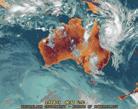
Step 6 Identify the different types of lines in this area.What does this tell you about rainfall?
• These activities challen ge students to conduct further research or complete group work to deepen their understanding of an issue or skill.
3C How can we manage tropical cyclones as a water hazard?3C SKILLS IN CONTEXT Cyclone Yasi Weblink Cyclone Yasi In early 2011 a severe tropical cyclone named Cyclone Yasi crossed ontoland in northern Queensland. Cyclone Yasi was a category 5 cyclone,which is the highest ranking of intensity for cyclones. In the early hours of 3 February, Yasi crossed the coast near Mission Beach, whichis located between Townsville and Cairns. With it, Yasi brought huge gale force winds,estimated at 285 kilometres per hour. Flights out of Queensland filled up quickly as thousands of people evacuated the area.Despite being one of the most powerful cyclones to have ever affected Australia, only onedeath occurred. However, the landscape was severely damaged: trees and power lineswere brought down, houses were destroyed and roads were damaged.In Cardwell, a small coastal town, the storm surge reached just under 7 metres. Practise the skill 1 Using the steps above, examine the map inSource 15. Extend your understanding 1 Using Source 15, describe the weather conditions inMelbourne on 2 February 2011. What was the weatherlikely to have been like a few days before this date? 2 Source 16 is a satellite image that shows Australia atthe same time as the situation shown in the map inSource 15. Explain the relationship between trough lines andclouds. b Use these images to write a reflection on how theweather can be so different in different parts ofAustralia at the same time. Source 16 Satellite image of Australia on 2 February 2011 Source: Bureau of Meteorology Source 15 Australia: Weather map of Australia, 2 February 2011 Source: Bureau of Meteorology Reading a weather map Weather maps show what is happening to the air and inthe atmosphere. They show air pressure (the movementof air rising, falling and spinning) as a series of lines.This helps meteorologists make predictions abouttemperature, wind and rainfall. We can use symbols on weather maps to predict theweather. For example, in Source 15, there is a dottedline to the east of Adelaide. Source 17 tells us that thisdotted line is known as a ‘trough’ that brings in rain. Inthe Southern Hemisphere, air moves slowly from west(left) to east (right). This means the trough has alreadypassed through Adelaide, so it is likely they experiencedrain in the days before this map was created. To predict the weather using a weather map,consider how the conditions in the atmosphere areaffecting a place, and follow these steps: Step 1 Look at the map. Is this location in the northernor southern hemisphere? In which direction willtroughs and cold fronts move? Step 2 Can you see any unusual patterns on the map, orare the symbols distributed evenly?
together the isobars,the stronger the wind. 1012 1016 L H TC High pressure cell Air rotates anticlockwise around a sinking air mass; conditions are warm and dry. 1012 1016 L H TC Low pressure cell Air rotates clockwise around a rising air mass; conditions arecool and wet.
1016 L H TC Cold front A line showing where coldair moves into an area and forces warm air to rise, cool and cause rain; cold fronts move in the direction of the arrowheads.
1016 L H TC Warm front A line showing where warmair moves into an area, rises and cools; this often produceslight rain and showers. 1012 1016 L H TC Trough line A long area of rising air oftenbrings a line of rain and sometimes thunderstorms. 1012 1016 L H TC Rainfall On some weather maps, shading is used to indicate aregion where rain is likely to fall. 1012 1016 L H TC Tropical cyclone Air rises rapidly and rotates clockwise with a calm centre; conditions are extremely windy and wet, and floodingis likely; cyclones move in thedirection of the arrow. Source 17 Weather map symbols For more information on this key skill, refer topage 25 of ‘The geography toolkit’. Test me! Once you’ve finished the topics in this section, test yourself with this quiz and find out which worksheet you should do. 102 OXFORD HUMANITIES AND SOCIAL SCIENCES 7 AUSTRALIAN CURRICULUM OXFORD UNIVERSITY OXFORD PRESS 103CHAPTER 3 VALUINg AND MANAgINg wATER
>
>
7–10
viii OXFORD HUMANITIES AND SOCIAL SCIENCES 7 AUS TRALIAN CURRICULUM OXFORD UNIVERSITY PRESS No part of this publication may be reproduced, stored in a retrieval system or transmitted in any form or by any means. DRAFT
Focus on engagement
Topic-based approach
• Chapter content is sequenced in numbered topics to support teaching and learning.
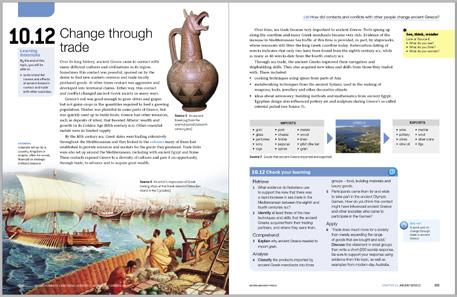
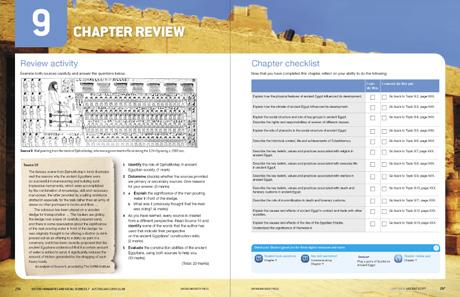
Learning intentions
• Each topic begins with a statement of learning intentions, which link the content to the curriculum.
Integrated digital resources
• Digital icons signpost a range of engaging reso urces that can be accessed via Student o book pro, including drag-and-drop activities, video quizzes, virtual site studies and quick quizzes. These resources are directly integrated with the topic being covered.
Source materials

• A variety of source materials such as photographs, maps, illustrations, text extracts and graphs will spark students’ curiosity and provide rich learning opportunities.
Focus on support for mixed-ability classrooms
Margin glossary terms
• On-page glossary definitions are provided for key terms, supporting students at their point of learning. Key terms also appear in a glossary at the end of the book, and can be revised in a fun Quizlet game via Student obook pro.
Easy-to-access text and design
• The text is written in clear and co ncise language and the text design is engaging and easy to navigate.
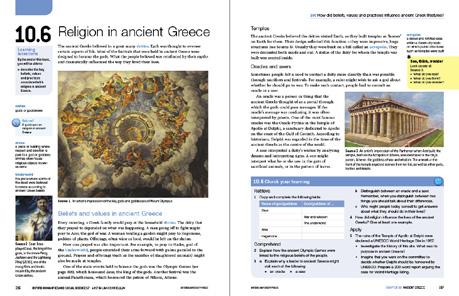
Focus on STEAM
Integrated STEAM projects
• Take the hard work out of cross-curricular learning with engaging STEAM projects. Two fully integrated projects are included at the end of each book in the series, and are scaffolded and mapped to the Humanities, Science and Maths curricula. The same projects also feature in the corresponding Oxford Science and Oxford Maths series to assist cross-curricular learning.
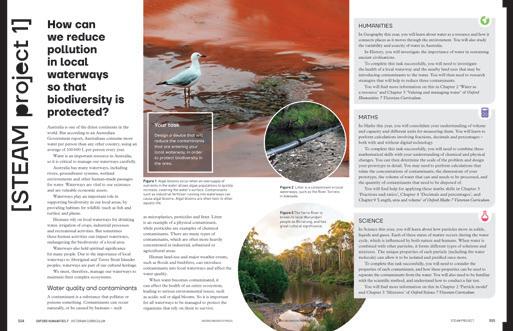
Structured questions
• Questions for each topic are gr aded according to the Marzano and Kendall taxonomy, catering for a range of abilities.
Chapter review
• At the end of each chapter, a review activity give s students the chance to consolidate their knowledge and apply the skills they have learnt throughout.
• Students are encouraged to self-assess their learning against a set of success criteria at the end of the chapter. If students do not feel confident about their learning, they are directed back to the relevant topic.
Problem solving through design thinking
•Each STEAM project investigates a real- world problem that students are encouraged to problem-solve using design thinking.
Full digital support
•Each STEAM project is supported by a wealth of digital resources, including student booklets to scaffold students through the design thinking process of each project, videos to support key concepts and skills, and implementation and assessment advice for teachers.
ixOXFORD UNIVERSITY PRESS INTRODUCING OXFORD HASS 7 AUSTRALIAN CURRICULUM No part of this publication may be reproduced, stored in a retrieval system or transmitted in any form or by any means. DRAFT
INTRODUCING OXFORD HASS 7–10
Key features of Student obook pro
> Student obook pro is a completely digital product delivered via Oxford’s online learning platform, Oxford Digital.
> It offers a complete digital version of the Student Book with interactive note-taking, highlighting and bookmarking functionality, allowing students to revisit points of learning.
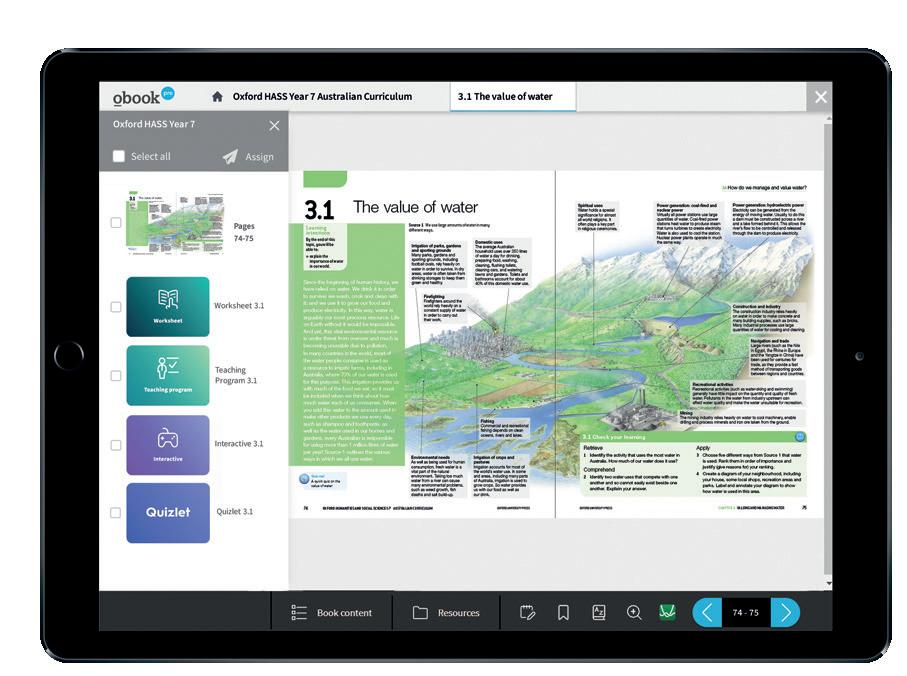
> A complete ePDF of the Student Book is also available to download for offline use and read-aloud functionality.
Focus on eLearning
Complete digital version of the Student Book
• This digital version of the Student Book is true to the print version, making it easy to navigate and transition between print and digital.
Interactive assessments
• Each topic in the Student Book is accompanied by an interactive assessment that can be used to consolidate skills and knowledge and for formative assessment.
Quizlet
• Integrated Quizlet sets, including real-time online quizzes with live leaderboards, motivate students by providing interactive games that can be played solo or as a class. Quizlet can be used for revision or as a warm-up activity when a chapter is introduced.
Additional resources
• A rich variety of additional resources such as interactive layered maps, videos, worksheets, quizzes and weblinks are linked to individual topics in the book so they can be accessed at the point of learning.
> integrated Australian Concise Oxford Dictionary look-up feature
> interactive assessments to consolidate understanding
> integrated Quizlet sets including real-time online quizzes with live leaderboards
> additional resources available at the point of learning
> access to their online assessment results to track their own progress
Integrated dictionary
• Each digital Student Book prov ides an integrated Australian Concise Oxford Dictionary lookup feature, so students can quickly access any terminology they aren’t sure of and continue their learning.
Benefits for students
• These interactive assessments are autocorrecting, with students receiving instant feedback on achievement and progress. Students can also access all their online assessment results to track their own progress and reflect on their learning. retrieval system or transmitted in any form or by any means.
x OXFORD HUMANITIES AND SOCIAL SCIENCES 7 AUS TRALIAN CURRICULUM OXFORD UNIVERSITY PRESS No part of this publication may be reproduced, stored in a
DRAFT
Key features of Teacher obook pro
> Teacher obook pro is a completely digital product delivered via Oxford Digital
> Each chapter and topic of the Student Book is accompanied by full teaching support. Teaching programs clearly direct learning pathways throughout each chapter and provide ideas for differentiation.
> Teachers can use their Teacher obook pro to share notes and easily assign resources or assessments to students, including due dates and email notifications.
Focus on assessment and reporting
Complete teaching support
• Teaching support provides full less on and assessment planning, ensuring there is more time to focus on students.
Additional resources
• Each chapter of the Student Book is accompanied by additional resources, including answers to every Student Book question, differentiated worksheets and class tests to monitor student progress.
Curriculum and assessment reports
• Teachers are provided with clear and tangible evidence of student learning progress through curriculum and assessment reports.
• Asses sment reports directly show how students are performing in each online interactive assessment, providing instant feedback for teachers about areas of understanding.

• Curric ulum reports summarise student performance against specific curriculum content descriptors and curriculum codes.
> Teachers have access to all student resources.
> As well as online assessment, teachers have access to editable class tests that are provided at the end of each chapter. These tests can be used as formative or summative assessment and can be edited to suit the class’s learning outcomes.
> As students complete online assessments, their results are measured against curriculum outcomes through the curriculum report. This allows easy understanding of how students are progressing, and where they may need support.
Benefits for teachers
xiOXFORD UNIVERSITY PRESS INTRODUCING OXFORD HASS 7 AUSTRALIAN CURRICULUM No part of this publication may be reproduced, stored in a retrieval system or transmitted in any form or by any means. DRAFT
Ancient Egypt
About 30 000 years ago, the Sahara Desert of north Africa was a grassy plain. It began to dry out around 8000 bce. This change in climate forced people in the region to move on. Many drifted towards the area next to the Nile River, where the land was more fertile and there was a good water supply.
From this simple start developed one of the world’s first civilisations –ancient Egypt. It lasted for nearly 3000 years. As the population grew, the society became more structured. Powerful rulers, called pharaohs, expanded Egypt’s territory. Huge monuments, temples and pyramids were built that would last for thousands of years. CHAPTER
Source 1 The Karnak temple is the largest religious building ever constructed. This city of temples was built over a period of 2000 years, from around 2055 bce to 100 ce . The temple at Karnak was built in tribute to the gods Amun, Mut and Khonsu, and was the location of an annual festival to honour these gods, which usually lasted around 27 days.
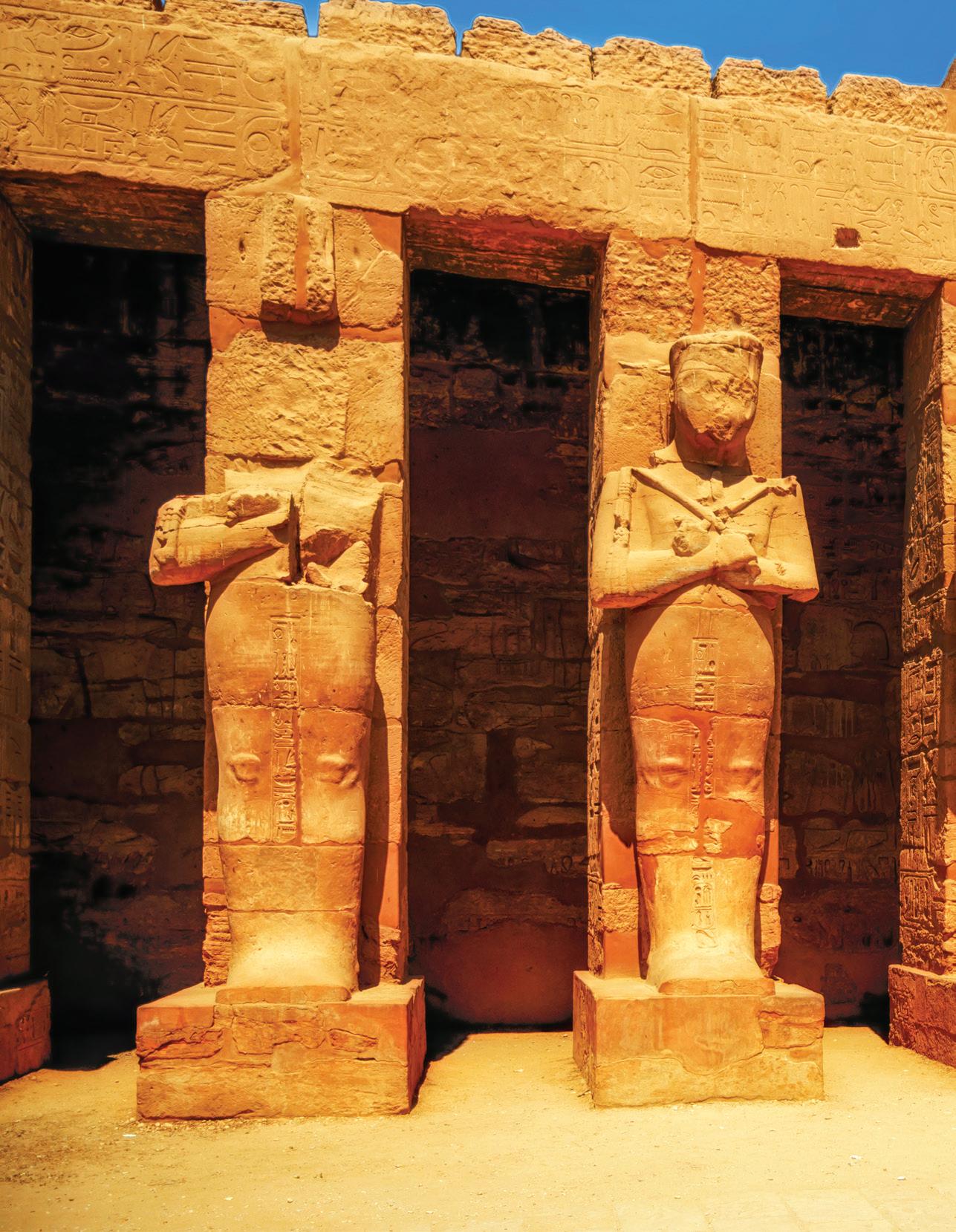
9
No part of this publication may be reproduced, stored in a retrieval system or transmitted in any form or by any means. DRAFT
How did the physical features of ancient Egypt influence its development?
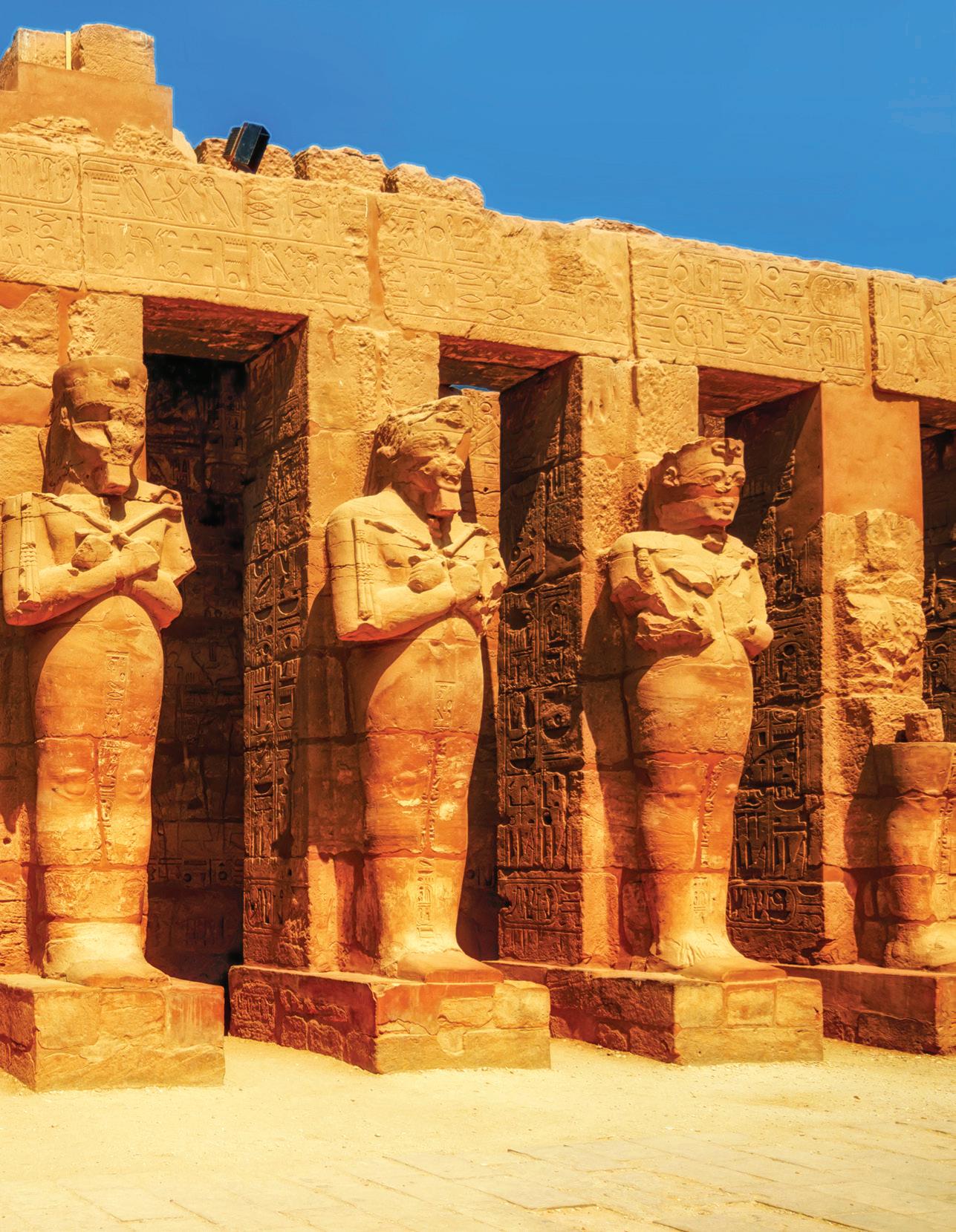
What shaped the roles of key groups in ancient Egypt?
How did beliefs, values and practices influence ancient Egyptian lifestyles?
How did contacts and conflicts with other people change ancient Egypt?
The ancient world 9A
9B
9C
9D
No part of this publication may be reproduced, stored in a retrieval system or transmitted in any form or by any means. DRAFT
Ancient Egypt: a timeline
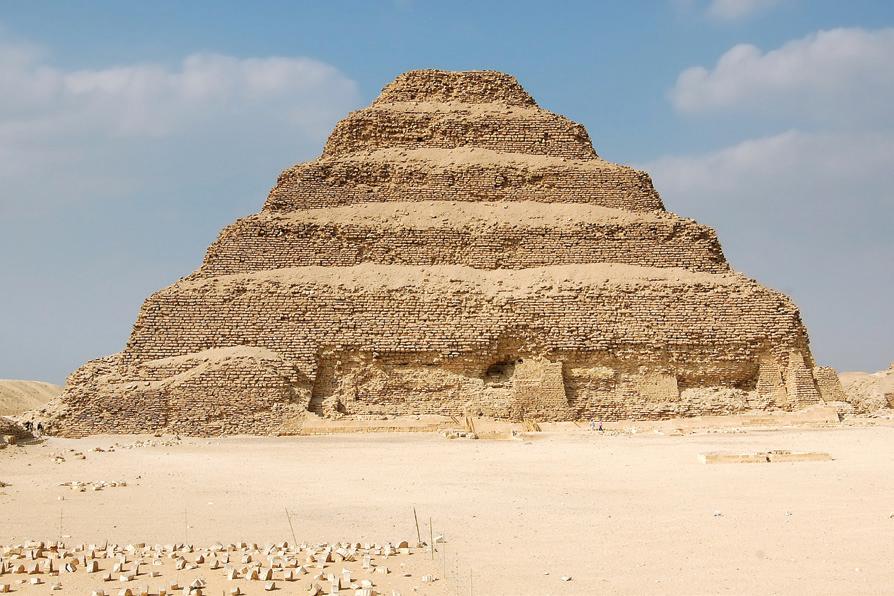



9.1 Source 1 A timeline of some key events and developments in the history of ancient Egypt Old Kingdom 2686−2180 BCE Middle Kingdom 2055−1730 BCE Predynastic period 8000−2700 BCE c. 2500 Building of Great Sphinx and Great Pyramid at Giza; Egyptians start experimenting with mummifying dead bodies. c. 8000 BCE People start forming settlements in the Nile valley. c. 2650 First stone pyramid is built in Saqqara for the pharaoh Djoser. c. 3200 Earliest known evidence of hieroglyphic writing c. 3100 Kingdoms of Upper and Lower Egypt unite as one country under the first pharaoh, Menes. c. 3000 Egyptians start building walled towns and villages; the first buildings are made of mud brick. c. 2100 Book of the Dead starts being used in funeral ceremonies. Egyptian hieroglyphs such as these have been essential in unlocking the history of ancient Egypt. 8000 BCE 3000 2000 The Great Sphinx of Giza The Djoser pyramid is the oldest building in the world made from cut blocks. Sequence this! Events in ancient Egypt 258 OXFORD HUMANITIES AND SOCIAL SCIENCES 7 AUS TRALIAN CURRICULUM OXFORD UNIVERSITY PRESS No part of this publication may be reproduced, stored in a retrieval system or transmitted in any form or by any means. DRAFT
Temple of the pharaoh
Hatshepsut in the Valley of the Kings, near Luxor

1479
Hatshepsut, a woman, becomes pharaoh.
1274
Pharaoh Rameses II claims victory against his enemies, the Hittites, at the Battle of Kadesh.
1332
Tutankhamun ascends the throne at the age of nine; he dies just 10 years later.
9.1 Check your learning
Retrieve
1 State the years in which the following events happened: a people first began to settle in the Nile Valley b the Great Sphinx and the Great Pyramid at Giza were built.


c Hatshepsut becomes pharaoh.
2 Who was Cleopatra? What was the length of her rule?
Analyse
3 Using the timeline, analyse when the period of the most change in ancient Egypt occurred. Remember, when you analyse something you must break it down into smaller parts and explain how they relate to each other.
Apply
This bust of Cleopatra was created during the time of her rule as the last pharaoh of Egypt.

51 Cleopatra becomes pharaoh of Egypt and rules for 21 years.
30 Cleopatra Egypt part of the Roman Empire.
4 The timeline shows that ancient Egyptian society began in approximately 8000 bce and ended about 332 bce
During this period, many historians identify four distinct eras, commonly known as the Predynastic period, the Old Kingdom, the Middle Kingdom and the New Kingdom. Investigate these periods and complete a chart with the following headings.
Period Date Key peopleInteresting facts
Remember to include references to show where you found your information.
9A How did the physical features of ancient Egypt influence its development? New Kingdom 1550−1069 BCE c. 1550 Construction of many royal tombs in the Valley of the Kings
commits suicide, and
becomes
1000
1 CE
CHAPTER 9 ANCIENT EGYPT 259OXFORD UNIVERSITY PRESS No part of this publication may be reproduced, stored in a retrieval system or transmitted in any form or by any means. DRAFT
Physical features of ancient Egypt9.2
Learning intentions
By the end of this topic, you will be able to:
» explain how the physical features of ancient Egypt influenced its development.
desert an area that receives less than 250 mm of rain every year; can be hot or cold
delta
a fertile area of land at the mouth of a river
Explore it!
A virtual field trip to the Nile
Ancient Egypt was a long, narrow country in north-eastern Africa. The world’s longest river, the Nile, ran the length of the country. Ancient Egyptian lands were also surrounded by a huge desert. These features played very important roles in the development of ancient Egyptian society.
The Nile begins in central Africa and flows north into the Mediterranean Sea. The desert made the Nile very important. The river’s delta provided the food and other resources needed by the Egyptian people. The Nile was so crucial for the society’s survival that the people worshipped it as a god. They called this god ‘Hapi’.
The Nile has three main sources – the White Nile, the Blue Nile and the Atbara River. The Blue Nile and the Atbara River begin in the highlands of central Africa. Every summer, they are flooded by melting snow and heavy rains. These waters gush into the Nile, carrying a load of dark mountain silt – soil that is rich in nutrients. Every year, this increase in water caused the Nile to gradually rise and flood parts of Egypt.
inundation
a term used for a flood; there was a yearly flooding of the Nile River in Egypt

Today, dams have been built along the Nile to prevent it from flooding, but in the days of ancient Egypt, these dams did not exist. Every year in June, the Nile would flood and leave a pile of dark, fertile soil all over the nearby land. This flooding season was known as the inundation. As soon as the floodwaters went back down, the farmers would plant crops such as barley and other grains. These crops would grow very quickly in this fertile soil.
The ancient Egyptians called the fertile land with rich dark soil around the river the ‘Black Land’. This was where most people lived. On each side of the Nile, beyond the Black Land, were large areas of desert. The ancient Egyptians named these areas the ‘Red Land’. Hardly anyone lived in the Red Land.

papyrus a type of riverside plant; the ancient Egyptians made paper from the crushed pulp of the plant
The Nile was important for other reasons too. It provided fresh water for drinking and bathing. The ancient Egyptians used spears and nets to catch fish in the Nile. They also caught the birds, such as ducks and geese, that lived near it and used them for food. They picked wild reeds, called papyrus, which grew alongside the river. The ancient Egyptians used these reeds to make a type of paper and boats. The Nile also allowed the ancient Egyptians to travel quickly from place to place, so that they could trade with each other.
260 OXFORD HUMANITIES AND SOCIAL SCIENCES 7 AUS TRALIAN CURRICULUM OXFORD UNIVERSITY PRESS No part of this publication may be reproduced, stored in a retrieval system or transmitted in any form or by any means. DRAFT

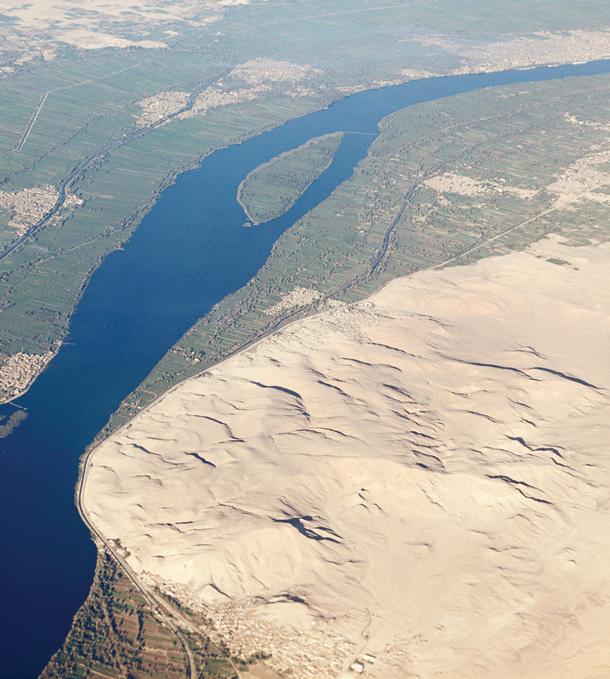
9A How did the physical features of ancient Egypt influence its development? ANCIENT EGYPT AND THE NILE 0 150 300 km Mediterranean Sea Lake Victoria Nile Blue Nile Atbara Nile Delta Nile White River River Red Sea Sahara Desert Cairo Luxor Abu Simbel Alexandria Giza Black land Red land LEGEND Source 4 Source: Oxford University Press Source 2 The boats and houses are modern, but this Nile scene is otherwise much as it would have been in the times of ancient Egypt. Source 3 An aerial photograph of the Nile showing the fertile valley (Black Land) and the bordering desert (Red Land) CHAPTER 9 ANCIENT EGYPT 261OXFORD UNIVERSITY PRESS No part of this publication may be reproduced, stored in a retrieval system or transmitted in any form or by any means. DRAFT
The importance of the Nile
The Nile was the lifeblood of ancient Egyptian society. It provided water for drinking and bathing; fertile soil for growing crops; fish and water birds for eating; and a means of transporting goods. The Nile also played a central role in the spiritual and religious beliefs of the Egyptians.
Interactive The importance of the Nile

Pleasure boats moved travellers up and down the river. Some boats were adapted as funeral boats to carry the bodies of pharaohs to their tombs.
The riverside papyrus plant was used to make a type of paper (also called papyrus), as well as boats, baskets and furniture.
Crops included wheat, barley, lentils, beans, onions, cucumbers, grapes, gs and dates. Trained baboons were sometimes used to pick fruit growing too high for people to reach.
Bricks were made from riverbank mud. It was sometimes mixed with straw for strength. The mud bricks were packed into moulds and left to dry hard in the sun.
Small shing boats were made from bundles of strapped papyrus reeds.
Flax plants were turned into a cloth called linen to make clothing.
River wildlife included sh, birds, frogs, crocodiles, eels, hippopotamuses and snakes. Ducks and geese were hunted with wooden sticks or caught in nets.
Severe oods could wash away all traces of farm boundary lines (usually marked with stones). Of cials known as ‘rope stretchers’ re-measured and re-marked any lines that had disappeared.
The river provided fresh water for drinking, beer making, cooking, washing and irrigation.
Source 5 An artist’s impression of the central role that the Nile played in ancient Egyptian life
262 OXFORD HUMANITIES AND SOCIAL SCIENCES 7 AUS TRALIAN CURRICULUM OXFORD UNIVERSITY PRESS No part of this publication may be reproduced, stored in a retrieval system or transmitted in any form or by any means. DRAFT
Farmers provided labour (during the inundation) to build structures such as the pyramids.
When the Nile ooded (known as the inundation) the river level rose around 8 metres. The silt it left behind on the oodplains fertilised the soil.

Villages were built on raised mounds above the usual ood line.
9A How did the physical features of ancient Egypt its development?
November to February
PROYET Growingseason
A network of canals (and later reservoirs) directed and stored river water for use in irrigation.
A shaduf was used to raise water from the river and direct it into irrigation canals.
9.2 Check your learnin g
Retrieve
1 Identify three ways in which the Nile was important to the ancient Egyptians.

2 Identif y the month that the Nile flooded each year.
Comprehend
3 Explain the main reasons that: a the Nile used to flood b the Nile no longer floods.
4 Describe why the ancient Egyptians called the land along the banks of the Nile the ‘Black Land’.
Analyse
Merchant boats and barges moved trade goods to and from markets. Barges also transported the massive stone blocks used to construct the pyramids.
5 Examine (look closely at) the illustration and labels in Source 5.
a Identify the devices the ancient Egyptians used or made to help store and distribute water to fields.
b What were the different purposes of boats used at the time?
6 Explain how the Nile influenced the ways in which buildings were made and villages designed.
7 Apply the information provided in Source 6 to decide which ‘season’ it would be currently in ancient Egypt. Explain what would be happening in this season. Apply
8 Using the internet, research how a shaduf worked. Propose (put forward) one modification or addition that would make it work better.
9 The Nile was so important to ancient Egyptians that it was worshipped as the god Hapi. Investigate the ways that the Egyptians worshipped Hapi.
Source 6 The ancient Egyptian seasons any means.
influence
AKHET– ’ Inundation’(flood i n g s e a s o n ) SHOMU –Harvestseason JunetoOctob e r MarchtoMay
263OXFORD UNIVERSITY PRESS CHAPTER 9 ANCIENT EGYPT No part of this publication may be reproduced, stored in a retrieval system or transmitted in any form or by
DRAFT
The climate of ancient Egypt9.3
Learning intentions
By the end of this topic, you will be able to:
» explain how the climate of ancient Egypt influenced its development.
Ancient Egypt was located within what is now the biggest desert in the world – the Sahara. This meant that the climate of Egypt was incredibly hot and dry.
Being surrounded by desert provided Egypt with some security. Any army that wanted to attack would have had a long, hot walk if invading from the east or the west.
Quiz me! quiz
The desert was inhabited by many different animals that were hunted by the ancient Egyptians for food. These animals included gazelles, hares and foxes. The desert was also the source of minerals, rocks and metals, which the Egyptians used for building houses, pyramids, statues and tombs, and making weapons and jewellery. The ancient Egyptians were able to trade many of these resources, as well as the products they made from them.

How the climate influenced lifestyle
Source 7 Climate gr aph for the city of Cairo
Living in a very hot and dry climate, the ancient Egyptians mostly lived an outdoor lifestyle. Most of them worked outside as farmers, fishers, builders and merchants. People cooked and often slept outside their homes (frequently on the roof) because of the heat.
Houses
Rich or poor, most Egyptians lived in houses that were similar in design. They had flat roofs and were made from sun-dried mud bricks. Most houses were single-storey structures.
The one-room homes of poor farmers had dirt floors. In urban areas, houses were joined, a bit like apartments and terrace houses are today.
Source 9 A headr est used by the wealthy while sleeping; it allowed air to circulate around the head and neck.
Source 8 Source: Oxford University
LOCATION OF ANCIENT EGYPT ON THE AFRICAN CONTINENT ATLANTIC OCEAN INDIAN OCEAN M e d i t e r ranean S e a Red Sea Lake Victoria Nile River AFRICA Sahara Desert EUROPE MIDDLE EAST Ancient Egypt Sahara Desert LEGEND 0 750 1500 km
Press
0 5 10 15 20 25 30 35 15 10 20 0 5 30 35 25 Rainfall Month Temperature (°C) JFMAMJJASOND Max. Min. Av. temp.
A quick
on the climate of ancient Egypt 264 OXFORD HUMANITIES AND SOCIAL SCIENCES 7 AUS TRALIAN CURRICULUM OXFORD UNIVERSITY PRESS No part of this publication may be reproduced, stored in a retrieval system or transmitted in any form or by any means. DRAFT
9A How did the physical features of ancient Egypt influence its development?
Fashion
The people of ancient Egypt dressed very lightly because of the heat. Men (including the pharaoh) often went barechested and wore short linen tunics. Women usually wore long linen dresses. Linen is a natural fabric, made from the flax plant, that allows sweat to evaporate more easily.
Most clothing was white, which is cooler than darker colours because it reflects the heat. Leather or papyrus sandals were sometimes worn by the rich, but most people went barefoot. Children and slaves were usually completely naked.
Living with dust and glare
Because of the desert surrounding ancient Egypt, dust, glare and wind-blown sand were a fact of life. Eye infections were common. Stone carvings have been found in tombs that show groups of blind people. Ancient papyrus texts show that bat blood was one treatment for eye problems. Another treatment was to rub a paste of mashed human brain and honey over the affected eye. Both men and women wore heavy eye make-up, called kohl, to help protect their eyes from dust and glare.
Men and women would also wear wigs, usually over a shaved scalp.
Shaving kept heads cool (when at home, without wigs) and allowed scalps to be kept clean. Sometimes, a cone of solid perfumed fat was worn on top of a wig on special occasions (see Source 11). As it slowly melted in the heat, sweetsmelling liquid dripped over the face and upper body, cooling the skin.
For more information on this key concept, see page 193 of ‘The history toolkit’.
Source 11 This detail from an Egyptian tomb show s a woman wearing heavy eye make-up and a cone of scented fat on top of her wig.

pharaoh the leader of ancient Egypt who was believed to be a god; the pharaoh had absolute power and total control
Source 10 Papyrus sandals from ancient Egypt; these would have been very cool to wear.

KEY CONCEPT Evidence
9.3 Check your learnin g
Retrieve
1 Identify three resources that the desert provided for the people of ancient Egypt.
2 Identif y where the people of ancient Egypt often cooked and slept.
Comprehend
3 In your own words, summarise the advantages and disadvantages of shaving your head and wearing a wig when living in a location like ancient Egypt.
Analyse
4 Examine (look closely at) Source 7.
a During which months, on average, was there no rain in Cairo? Identify the average temperature for each of these months.
b Melbourne’s highest rainfall occurs from September to December, with monthly rainfall averaging between 58 and 66 millimetres in those months. Identify some of the differences between average rainfall in Cairo and average rainfall in Melbourne.
Apply
5 Evaluate the positives and negatives of Egypt’s climate. Remember, when you evaluate something you should talk about its strengths and weaknesses. Be sure to give your overall opinion.
6 Create a diary entry in which you describe the climate and desert of ancient Egypt, as if you had lived there.
CHAPTER 9 ANCIENT EGYPT 265OXFORD UNIVERSITY PRESS No part of this publication may be reproduced, stored in a retrieval system or transmitted in any form or by any means. DRAFT
SKILLS IN CONTEXT 9A Irrigation in ancient Egypt
The annual inundation (flooding) of the Nile was so important to the ancient Egyptians that they organised their lives around it.
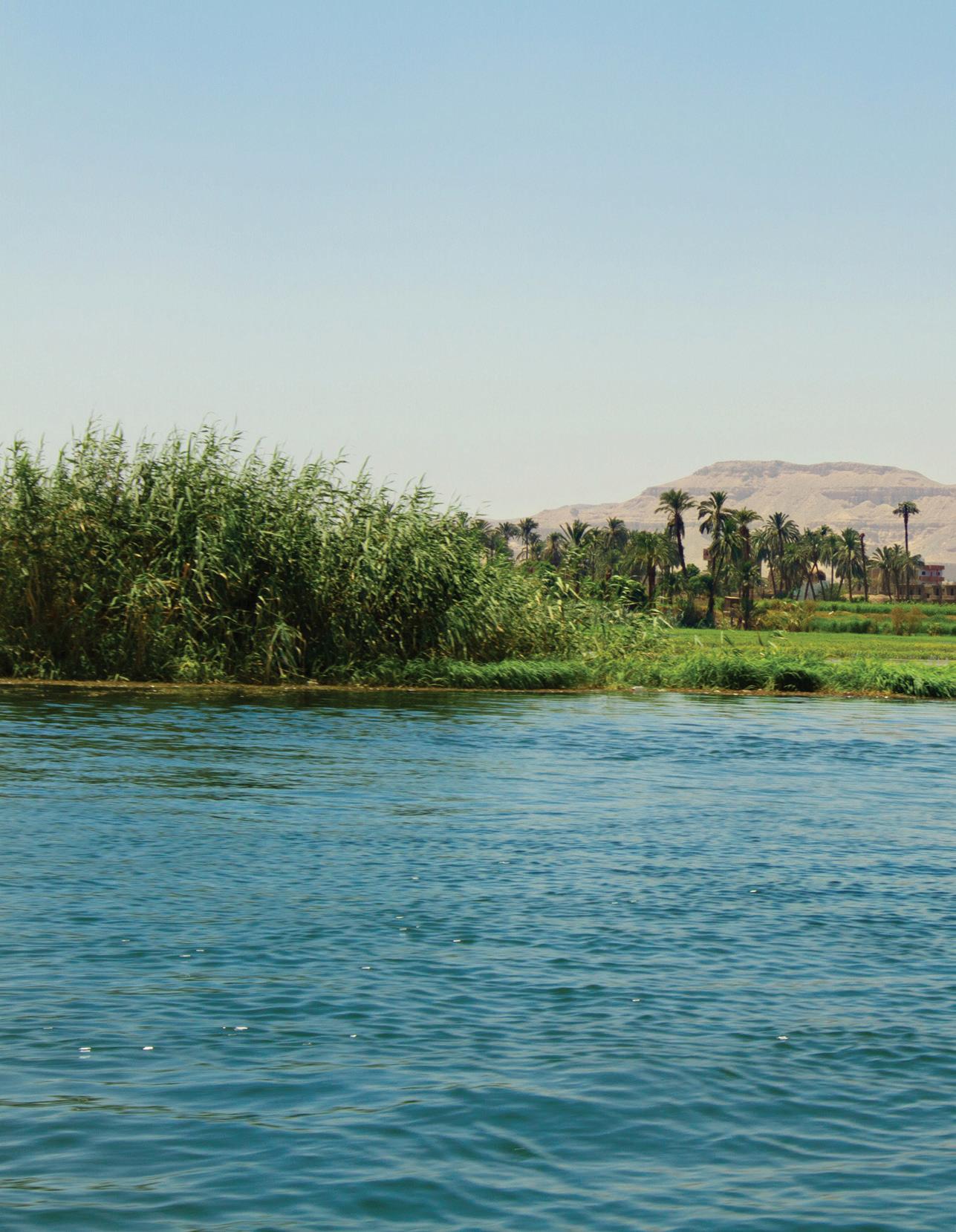
Test me!
Once you’ve finished the topics in this section, test yourself with this quiz and find out which worksheet you should do.
Flooding happened in a season the Egyptians called akhet. As the flood receded, the fertile silt left on the ground near the river ensured perfect conditions for proyet, the growing season, which was when farmers would plant and grow their crops. The crops would continue to grow until they were picked in shomu, harvest season. During proyet the ancient Egyptians needed to irrigate (water) the crops they had planted. They experimented with many different kinds of irrigation over the course of their history.
KEY SKILL
Using historical sources
Interpreting primary sources
Primary sources are things that were created during the time being studied. They can be documents, objects, paintings and other sources that provide us with a firsthand account of what life was like in the past.
Because they are firsthand accounts, primary sources often convey the creator’s point of view, attitudes and values. It is important that you can identify and describe these elements in their work. Use the following steps:
Step 1 Ask yourself what factual information is conveyed in this source. (Be careful: sometimes things that are presented as fact are not always accurate, so you might need to think about whether the information can be verified. Where else might you look to check and make sure those ‘facts’ are accurate?)
Step 2 Think about how the world described or depicted in the source is different from the world you
live in today. What do you already know about what the creator of the source and the people around them believed? How would you feel if you were in the creator’s shoes?
Step 3 Ask yourself what opinions are expressed in the source. If the source is written, which specific words or phrases show how the writer feels?
Step 4 Ask yourself what is implied in the source. For instance, people do not always spell out what they are thinking when they write something. The reader needs to use clues in the text to ‘read between the lines’ and infer meanings that are not spelled out. The following primary sources provide evidence about the beliefs, values and attitudes of the ancient Egyptians towards the Nile and the annual inundation, as well as important types of irrigation technology that were developed. For more information on this key skill, refer to page 205 of ‘The history toolkit’.
Source 16 The Nile River
OXFORD UNIVERSITY PRESSOXFORD HUMANITIES AND SOCIAL SCIENCES 7 AUSTR ALIAN CURRICULUM266 No part of this publication may be reproduced, stored in a retrieval system or transmitted in any form or by any means. DRAFT
Worksheet
Practise the skill
1 Read Source 15 carefully.
a Identif y the factual information in this source.
b Explain the writer’s beliefs and attitudes about the annual cause of the inundation. Remember to identify the specific words or phrases in the source that support your conclusion.
c What can you tell about the writer’s values?

2 Use Sources 12, 13 and 14, and information gathered on the internet, to compare the use of canals, shadufs and waterwheels in ancient Egypt. Log onto your obook pro to complete the worksheet: Irrigation technology in ancient Egypt.


Source 15
Hail to you, Nile River! You show yourself over this land, and come to give life to Egypt! Your source is mysterious, but we celebrate the day when you come to us! Watering the orchards created by Ra, to cause all the cattle to live, you give the earth to drink, inexhaustible one!
…
Lord of the fish: during the inundation, no bird lands on the crops. You create the grain, you bring forth the barley, you make sure the temples will last for eternity. If you stop your toil and your work, then all that exists in our world will be in trouble. Extract from ‘Hymn to the Nile’, written c. 2100 bce in ancient Egypt
Extend your understanding
1 Using the results of your research, write a short report on the history of irrigation technology in ancient Egypt. Make sure you:

• include an introduction explaining why irrigation was so important in ancient Egypt
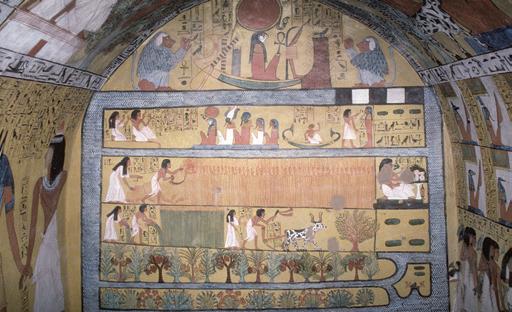
• include a main body, broken up into sections (with subheadings) that describe each type of technology (for example, ‘Canals’, ‘Shadufs’ and ‘Waterwheels’)
• explain within each section when this type of irrigation technology was invented and how it worked. Include diagrams if you wish.
Irrigation technology in ancient Egypt stored in a retrieval system or transmitted in any form or by any means.
9A How did the physical features of ancient Egypt influence its development?
Source 13 Shadufs were used in ancient Egyptian irrigation. This painting of a man drawing water from the Nile with a shaduf was found in the tomb of Ipuy, at Deir el-Medina, Egypt.
Source 12 Canals were an important form of irrigation in ancient Egyp t. A simple Egyptian canal system is depicted in this painting, found in the tomb of a commoner named Sennedjem.
Source 14 This tr aditional waterwheel near Luxor, Egypt, is similar in design to those used in ancient times. The water comes out of the well on a second wheel carrying clay water jugs (shown to the right). This water then supplies the irrigation network. clay water jugs
CHAPTER 9 ANCIENT EGYPT 267OXFORD UNIVERSITY PRESS No part of this publication may be reproduced,
DRAFT
Key groups in Egyptian society9.4
Learning intentions
By the end of this topic, you will be able to:
» explain the social structure and role of key groups in ancient Egypt
» descr ibe the rights and responsibilities of women of different classes.
hierarchy a way of organising things (or people) from top down in order of importance or significance; ancient societies had strict hierarchies with a ruler at the top and the peasants or slaves at the bottom
The society of ancient Egypt was well organised. Ancient Egyptians had a central government and, from the fifteenth century bce, they also had a professional army. People knew what their social responsibilities were. Some of these roles were shaped by the society’s laws and traditions. Some were determined by religious beliefs. Other roles were determined by a person’s wealth and abilities (such as whether they could read and write).
The society of ancient Egypt was a hierarchy. At the top was the royal family: the pharaoh and his family. At the bottom were the slaves and the poorest of the poor farmers.
Men usually did the jobs their fathers did. They learnt the skills a bit like apprentices learn trades today. Education was the key to improving a person’s position in society. A merchant, or even a farmer, could do this by learning to read and write.
Nomarch
I govern one of our country’s 42 nomes (provinces). I keep the Vizier happy by collecting lots of taxes. Like other important and wealthy people, I wear garments made from the finest linen and lots of gold jewellery.
scribe a highly educated person in ancient Egypt who was able to read and write

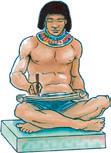



Scribe
I am one of the very few people in Egypt who can read and write. I record the pharaoh’s orders and decisions, and help the Vizier and the Director of the Seal to keep tax records. I also keep accounts for the army, write letters for local people and prepare inscriptions for tomb walls and sculptures. I hope one day to become a doctor or an architect.
Merchant
I am a trader. I am constantly sailing up and down the Nile with goods from Egypt, such as linen, papyrus, pottery, grain and gold. Goods I bring back from other places include ebony wood, ivory, incense, copper and baboons. Every now and then, I sail north, across the Mediterranean Sea.
Linen workshop supervisor
I was at home for many years raising my seven children. To help out, I made linen from flax. My husband used to trade it in the local market for other things that we needed. I now have a supervisor’s job, managing women in a linen workshop.
Slave
I was born in Libya, but was captured as a prisoner of war. Other slaves come from Syria and Nubia. My master uses me as a field hand. Some of the lucky slaves work in the palace of the pharaoh – much better than working in the quarries or mines out in the hot desert.
Source 1 The social hierarchy (structure) of ancient Egypt
268 OXFORD HUMANITIES AND SOCIAL SCIENCES 7 AUS TRALIAN CURRICULUM OXFORD UNIVERSITY PRESS No part of this publication may be reproduced, stored in a retrieval system or transmitted in any form or by any means. DRAFT
Pharaoh
My main duty is to keep life in balance – on this Earth and beyond. I govern with a large team of officials.
Vizier
I am the pharaoh’s second-in-command.
I supervise the other officials and judge law-breakers. I also make sure people pay their taxes, in grain or goods. Sometimes people provide their labour as a tax payment.
Priestess
My husband is a nomarch. In fact, most of my fellow priestesses are married to senior officials – the high priestess in our temple is a daughter of the pharaoh. My main role is to help look after the temple goddess and to sing and play music if the pharaoh visits our temple. I report to the chief priest.

Soldier
Director of the Seal
I am the treasurer. I manage all the goods (food and other products) that come into the pharaoh’s storehouses. Most of these goods are tax payments, but some items are imports from other countries.
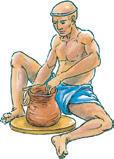

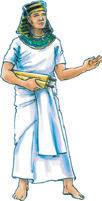
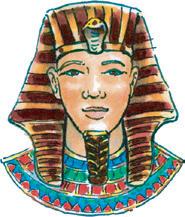

Chief priest
Source 2 Inside the tomb of Rameses VI; in keeping with the pharaohs' position at the top of the social hierarchy, their tombs were grand and highly decorated.

I represent our country’s top priest, the pharaoh, and look after the gods. I enter the inner part of the temple where the statue of the god is kept. Each day I wash it, wrap it in clean linen and bring it food. If I didn’t do this, bad things would happen. On special days, I take it out to show the people. My priests and I don’t wear clothing made from animal products because that would be unclean. We wear only the finest white linen. We shave all our body hair and wash many times each day.
I am a soldier. I am very skilled at using a pike (spear). I march on foot but our army also has charioteers. Our army divisions –all named after gods – usually consist of about 5000 men. Often, I fight alongside mercenaries – men from other countries who are paid to fight for us. Many of them come from Nubia. When not at war, I help out by supervising building projects.
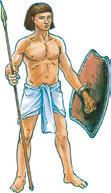

Stonemason
I spend my days making stone statues (usually of my pharaoh), carving the blocks used to build temples and pyramids, and engraving the walls of tombs. My father was a stonemason, too, of course. Until she went blind, my mother made wigs from real hair.
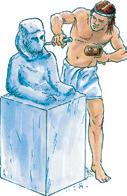
Farmer and his wife
Quiz me!
Potter
I am a member of the middle class – not too poor, but not too rich either! I give some of the pots I make to the pharaoh as a tax payment. Some of my pots are exported to other countries. Most of my friends are craftsmen, too. We learnt our trades from our fathers. Some make jewellery; others make papyrus, boats or furniture. I wish I was smart enough to be a scribe.
Except for slaves, we are at the bottom of the social ladder (along with tomb builders, pig herders and beggars). I grow wheat and barley, and flax used to make linen. My wife here helps me in the field when she can. I work very hard, digging canals for irrigation and preparing the soil. During the inundation, I often help out with the pharaoh’s building work. I pay over half of the grain I produce as tax.
A quick quiz on key social groups in Egyptian society by any means.
9B What shaped the roles of key groups in ancient Egypt?
CHAPTER 9 ANCIENT EGYPT 269OXFORD UNIVERSITY PRESS No part of this publication may be reproduced, stored in a retrieval system or transmitted in any form or
DRAFT
The role of women
The role of most women in ancient Egypt was to raise a family. Pregnancy was always a celebrated event. It was common for a woman to have lots of pregnancies, and many women died in childbirth. Girls were often married as young as 12, and were expected to have children quickly. Life expectancy was low. A poor woman might only live until she was 30.
Rich and poor women
Poorer women usually devoted their entire lives to raising their children, keeping house and helping their husbands with planting and harvesting crops.
Upper-class women, such as the wives of pharaohs and nobles, had a more pampered life. They had servants to wait on them, and fine clothing and jewellery to wear (see Source 2). If they were the eldest child, they inherited their father’s wealth.
Rights and freedoms of women
The man was the head of the household in ancient Egypt, but women had more freedom than in many other ancient societies, such as ancient Greece. This may partly be because of Egyptian religious beliefs. The ancient Egyptians saw their world as being controlled equally by male and female deities
Women could own land and businesses, keep the children if there was a divorce, and openly breastfeed their children. They could make wills, testify in court and bring legal actions against men. Women could also hold jobs. For poorer women, a job meant manual labour. They might work on farms, look after animals or become weavers; some might have worked as singers or dancers. Wealthier women might work as priestesses.
 deities gods or goddesses
Source 3 This wall art from the Tomb of Nebamun was painted about 4500 years ago in Thebes. It shows Egyp tian women celebrating at a feast, attended by servants.
deities gods or goddesses
Source 3 This wall art from the Tomb of Nebamun was painted about 4500 years ago in Thebes. It shows Egyp tian women celebrating at a feast, attended by servants.
270 OXFORD HUMANITIES AND SOCIAL SCIENCES 7 AUS TRALIAN CURRICULUM OXFORD UNIVERSITY PRESS No part of this publication may be reproduced, stored in a retrieval system or transmitted in any form or by any means. DRAFT
9B What shaped the roles of key groups in ancient Egypt?
The role of slaves
Many people think that slaves were used to build the pyramids. Actually, there is little evidence to support this. Records suggest that there were not many slaves during the Old Kingdom, when the pyramids were built. Rather, it is thought they were built by peasants and farmers who could not work on the land during the rainy season.
The number of slaves in ancient Egypt did increase during the Middle and New Kingdoms. Most were prisoners of war. Others were bought and sold at markets, or were unlucky travellers captured by slave traders.

Most slaves in Egypt lived fairly pleasant lives. Their role often was to be a faithful servant in the households of pharaohs, nobles and priests. They could own land and hire servants. They could marry those who were not slaves. Some talented or beautiful slaves were able to get promoted to senior or privileged positions.
Less fortunate slaves were sent to work in the gold and copper mines of north Africa’s deserts. They often died of thirst or heat exhaustion.
Considering perspectives
As with today, a person’s experience and perspective of the world was influenced by their standing in ancient Egyptian society. For example, the pharaoh was likely to have experienced life in a way that was very different to that of a farmer. It is therefore important to ask questions about where a primary source comes from, why it was created, and what it tells us about the world it portrays.
Look closely at Source 3. This painting depicts Egyptian women celebrating at a
feast. These women are being attended by servants, which suggests that they were rich women with a high standing in society. Think about how the perspectives of the women in this painting would be different to that of the slaves. Do you think they would have the same perspective, or would it be different?
Log onto your obook pro to complete the Key skill worksheet: Historical perspectives and interpretations: Considering perspectives.
Source 4 An engraving showing roped slaves on the stone wall leading into the Great Temple of Rameses II at Abu Simbel
KEY SKILL Historical perspectives and interpretations
Key skill worksheet
Retrieve
1 List these social roles in order (from most to least important) according to the values of ancient Egyptian society: potter, merchant, pharaoh, farmer, priestess, vizier, scribe.
2 Describe how a farmer’s social role and standing might change if he learnt to read and write.
3 Identif y the types of duties most slaves were expected to carry out. What types of duties were less fortunate slaves expected to carry out?
Comprehend
4 In your own words, summarise how religious beliefs in ancient Egypt shaped the role of women.
Analyse
5 Compare the roles of a chief priest and the vizier in ancient Egypt. Remember, when you compare two things you must talk about how they are similar and how they are different.
6 Compare the perspectives of rich women and poor women in ancient Egypt. How might these two groups of women have perceived life in ancient Egypt? Do you think it would be similar or different?
Apply
7 The powerful roles in ancient Egyptian society were those of people who were wealthy, had political power or had religious authority. As a class, discuss the extent to which this represents the situation in Australia today.
Historical perspectives and interpretations: Considering perspectives or any form or by any means.
9.4 Check your learnin g
271OXFORD UNIVERSITY PRESS CHAPTER 9 ANCIENT EGYPT No part of this publication may be reproduced, stored in a retrieval system
transmitted in
DRAFT
Learning intentions
By the end of this topic, you will be able to:
» explain the role of pharaohs in the social structure of ancient Egypt.
Pharaohs
The pharaoh was the head of Egyptian society and was almost always a man. Pharaohs were regarded as god-kings, and were seen as descendants of Ra, the sun god. People knelt and kissed the ground when they met the pharaoh.
Pharaohs were very wealthy, owning all the land and its resources. They placed taxes on the people, which were usually paid to them in the form of grain and other crops. In addition to power, pharaohs had a number of responsibilities, some of which were shaped by law, others by religion (see Source 5).
Source 5 Responsibilities of the pharaoh as god-king
Earthly responsibilities (shaped by the law)Divine responsibilities (shaped by religion)
The pharaoh was responsible for:
› directing the government
› commanding the army and leading it into battle
› protecting the people and keeping peace and order
› making all laws, and sometimes making decisions in the courts
The pharaoh was responsible for:
› acting as chief priest
› keeping the gods happy so the Nile flooded every year and harvests were plentiful
› choosing priests
Analyse this! power of the pharaohs
› managing building, mining, trade and irrigation.
› overseeing religious ceremonies and festivals
› building temples to honour the gods
› performing religious duties.
A crown symbolised the pharaoh’s position as chief ruler. The crown shown here was the official crown; its design is a combination of the white crown of Upper Egypt and the red crown of Lower Egypt that merged to form a united Egypt. Pharaohs also wore a range of other headgear depending on their duties.

The uraeus (gold headpiece shaped like an upright cobra) symbolised magical powers and a readiness to strike.
A false beard made from goat’s hair symbolised the pharaoh’s status as a god.
The heavy jewelled collar symbolised great wealth.
The flail (whip) symbolised total authority.
The crook symbolised the pharaoh’s role as a shepherd of the people.
An animal tail (usually from a bull) symbolised strength and fertility.
Source 6 An artist’s impression of a pharaoh and their symbols of power
9.5
1 2 3 4 5 6 7
1 2 3 4 7 6 5
The
272 OXFORD HUMANITIES AND SOCIAL SCIENCES 7 AUS TRALIAN CURRICULUM OXFORD UNIVERSITY PRESS No part of this publication may be reproduced, stored in a retrieval system or transmitted in any form or by any means. DRAFT
9B What shaped the roles of key groups in ancient Egypt?
The rulers of ancient Egypt
By about 3300 bce, the Nile settlements were grouped into two kingdoms: Upper Egypt and Lower Egypt. These united in about 3100 bce. For the next 2800 years, the unified kingdom of Egypt was ruled by pharaohs, thus creating the world’s first national government.
Dynasties
The laws and traditions of ancient Egypt meant that a pharaoh passed on his power as ruler to the son (usually the eldest) of his main wife – in the ancient world, it was common for men to have more than one wife. If the main wife did not have a son, the son of a less important wife would become the new ruler, or heir. The period of time where members of the same family ruled was known as a dynasty Sometimes, someone from outside the family seized power and became pharaoh. This meant the start of a new dynasty.
In 332 bce, Egypt was conquered by the king of Macedon (modernday Macedonia), known as Alexander the Great. He started what was to be the last dynasty in ancient Egypt, known as the Ptolemaic Dynasty. This dynasty lasted until 30 bce when its last ruler, Cleopatra, committed suicide. After that, Egypt became part of the Roman Empire.
Hatshepsut – 18th-dynasty ruler

Hatshepsut was one of few female pharaohs. She ruled between about 1473 and 1458 bce. When she became pharaoh, she wore a false beard, men’s clothing and a bull’s tail, and changed her name to its male form. She ordered the construction of many buildings, paid for many trading expeditions, and rebuilt trade routes that had been damaged by former invaders.
9.5 Check your learnin g
Retrieve
1 State the main difference between the pharaoh’s divine role and earthly role.
2 In your own words, define the term ‘dynasty’ and give reasons why a dynasty usually changed.
3 Look at Source 6. Copy this table in your notebook, and add at least three items to each column.
Item worn or carried by the pharaoh
Analyse
heir a person who has the legal right to receive somebody's property, money or title when that person dies dynasty a period of rule by members of the same family who come to power one after the other
What it symbolised
Apply
5 Consider some of the items the following people wear or carry to reflect their social position or role. For each item, determine what it symbolises:
• the Queen
• a high-ranking soldier
• an Australian High Court judge
• the principal of your school.
6 a How did Hatshepsut adjust her appearance to suit her role as pharaoh? Discuss why she would have made these changes.
4 Consider why the ancient Egyptians knelt and kissed the ground when they met the pharaoh.
b Do you think people today feel pressured to change their appearance and behaviour when they move into a public leadership role? Discuss with a partner. Give examples if possible.
Source 7 An ancient stone carving of the female pharaoh Hatshepsut any or by any means.
CHAPTER 9 ANCIENT EGYPT 273OXFORD UNIVERSITY PRESS No part of this publication may be reproduced, stored in a retrieval system or transmitted in
form
DRAFT
Significant individual: Tutankhamun9.6
Learning intentions
By the end of this topic, you will be able to:
» descr ibe the historical context, life and achievements of Tutankhamun.
Tutankhamun ( c . 1342–1323 bce) is the world’s best-known pharaoh and one of the most studied figures in history. He was a boy when he became pharaoh in 1332 bce and only ruled for 10 years, yet his story still captivates people all over the world.
Scientific analyses of his remains reveal that he was about 170 centimetres tall, with a slight bend in his spine. He had an overbite, a cleft palate and an elongated skull. He was only 19 when he died. He did not live long enough to do much that was remarkable. He did, however, change the command of his predecessor, Akhenaten, that the people only worship one god – Aten, the sun god.
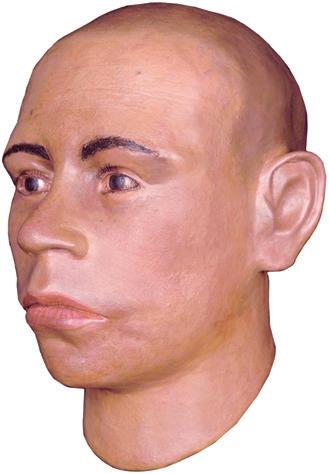
Tutankhamun declared that Egypt’s old gods could again be worshipped. He restored their temples, priests and festivals. He also reversed Akhenaten’s decision to move ancient Egypt’s capital. He moved the capital to Memphis.
Despite his short life, Tutankhamun is significant because his tomb is the only ancient tomb in Egypt so far found not to have been broken into by robbers. It contained over 5300 sources of evidence of his life and burial practices at the time. These sources include his decorated gold throne and his nest of coffins.
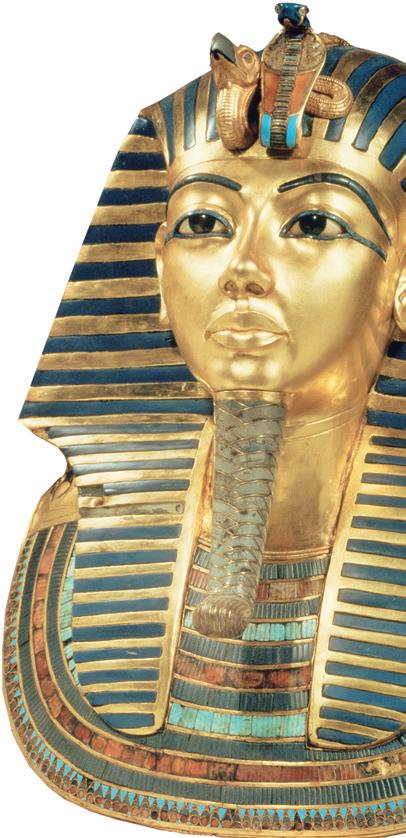
Source 9 The reconstructed head of Tutankhamun
The discovery of Tutankhamun’s tomb
canopic jars jars used in ancient Egypt to store body parts removed during the mummification process mummy a body prepared for burial or entombment in ancient Egypt
amulets charms thought to keep away evil
The English archaeologist Howard Carter found the tomb in 1922. It was at the end of a long tunnel in the Valley of the Kings. This was a deep, rocky valley close to the Nile where many pharaohs were buried. Carter reported: ‘At first I could see nothing … but as my eyes grew accustomed to the light, details of the room within emerged slowly from the mist, strange animals, statues and gold – everywhere the glint of gold!’
Tutankhamun’s mummy lay within a solid-gold body-shaped coffin (110 kilograms in weight) in the burial chamber. This coffin was enclosed by two more coffins. In the treasure chamber next door were four canopic jars holding the pharaoh’s mummified liver, lungs, stomach and intestines.
His body was covered in amulets and jewels, and he was wearing an 11-kilogram solid-gold burial mask inlaid with precious stones. Carter and his team used hot knives to remove the mask. They also cut up the body to retrieve the jewels and amulets that were wrapped up in his bandages.
274 OXFORD HUMANITIES AND SOCIAL SCIENCES 7 AUS TRALIAN CURRICULUM OXFORD UNIVERSITY PRESS No part of this publication may be reproduced, stored in a retrieval system or transmitted in any form or by any means. DRAFT
How Tutankhamun died
To this day, historians cannot agree on how Tutankhamun died. Some historians used to think he was murdered, because there was a hole at the back of his skull and a floating piece of bone behind his eyes. This view has been contested in more recent years.
In 2005, an extensive number of CT scans (special X-rays) were taken of Tutankhamun’s remains. These scans led the
Egyptian archaeologist Zahi Hawass to conclude that he died of a complication from a broken leg – specifically, gangrene (which is the rotting away of living tissue).
He thinks the break in the leg became infected. The hole in the skull, he thinks, might have been a mummification accident. Other historians have found evidence to suggest that Tutankhamun might have had malaria, which could have contributed to his death.

For more information on this key concept, see page 193 of ‘The history toolkit’.
Since then, conservators (people responsible for preserving important historical sources) became more worried about the damage that was still being done to Tutankhamun’s mummy. When visitors entered the tomb, their breath and body heat caused damage to the mummy and other parts of the tomb. Tutankhamun’s remains stayed within his coffin until November 2007, when they were moved into a special, climate-controlled case within the tomb.
KEY CONCEPT Evidence
mummification the process of preserving a dead body by preventing its natural decay; in ancient Egypt a body was mummified by removing internal organs (except the heart) and drying out the remaining body tissue, and the mummy was then buried
I used to think, now I think
Reflect on your learning about Tutankhamun and complete the following sentences.
• I used to think …
• Now I think … What has changed in your understanding?
Check your learnin g
Retrieve
1 Who was Tutankhamun?
2 Identif y two changes that Tutankhamun made during his reign.

Comprehend
3 Tutankhamun did not live long enough to do much that was considered remarkable. Explain why historians still regard him as significant.
Analyse
4 Analyse the treatment of Tutankhamun’s remains by archaeologists. How has the discovery of his remains put them at risk? Has enough been done to help conserve them?
5 Reflect on why the cause of Tutankhamun’s death has been contested by historians. Apply
6 Create a diar y entry that Howard Carter might have written after discovering Tutankhamun’s tomb. Use the internet to research more about the discovery and the tomb’s contents.
Source 10 The gold mask found fused to Tutankhamun’s head and upper body
Sour ce 8 The mummified head of Tutankhamun
9B What shaped the roles of key groups in ancient Egypt?
Quiz me! quick quiz on Tutankhamun
A
CHAPTER 9 ANCIENT EGYPT 275OXFORD UNIVERSITY PRESS No part of this publication may be reproduced, stored in a retrieval system or transmitted in any form or by any means. DRAFT
SKILLS IN CONTEXT 9B Farming in ancient Egypt
Test me!
Once you’ve finished the topics in this section, test yourself with this quiz and find out which worksheet you should do.
Farmers in ancient Egypt prospered because of the fertile land along the banks of the Nile. Farming was so central to the success of ancient Egypt that many aspects of society were shaped by it, such as the calendar, the design of houses, even the class system. Most of the pharaoh’s wealth came from the taxes paid in grain by farmers. This grain was stored in plentiful years for use when food was in short supply.

KEY SKILL
Using historical sources
Using primary sources as evidence
Historians focus their research on sources that are relevant. After locating a range of sources that they think might be useful, historians need to analyse them to discover if they contain evidence that will be relevant to the particular question they are investigating. The evidence is the information contained in or gathered from the source. A source becomes evidence if it can be used to answer a particular question about the past.
The first thing you must do before attempting to locate, compare, select and use a range of sources as evidence is to be very clear about the historical questions you are investigating. In this Key skill, your research questions are:
• What were farming practices like in ancient Egypt?
• What role did farmers have in the social hierarchy?
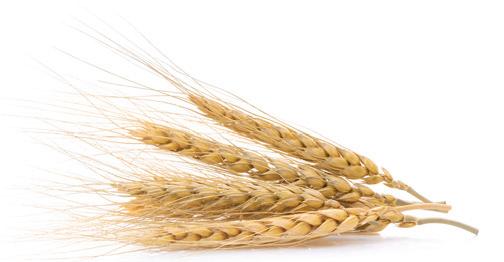
You need to keep these questions in mind as you work through the following steps:
Step 1 Look at the source carefully and note the obvious things that it is telling you.
Step 2 Look beyond the obvious and see what you can infer; that is, what can you work out from what you see in the source, even though it may not be immediately obvious?
For a more information on this key skill, see page 205 of ‘The history toolkit’.
Source 12, a wall painting from the tomb of an important official called Menna, provides a lot of information about ancient Egyptian farming, including crops, tools and farming methods. It is a
Source 11 The banks of the Nile River
OXFORD UNIVERSITY PRESS276 OXFORD HUMANITIES AND SOCIAL SCIENCES 7 AUSTR ALIAN CURRICULUMNo part of this publication may be reproduced, stored in a retrieval system or transmitted in any form or by any means. DRAFT
Source 12 This is a detail from a wall painting in the tomb of Menna, an important official from ancient Egypt. The painting (c. 1400–1390 bce) contains detailed information about farming practices in ancient Egypt.

Practise the skill
1 Each farming activity listed below has a letter beside it. E xamine the painting and numbers in Source
12. Find the section of the painting that shows each activity and write the matching letter and number in your notebook.
A Cutting grain with scythes (metal cutting tools)
B Threshing (beating) the grain
C The arrival of a noble to check grain stores
D Picking fruit
E Preparing for planting
F Stopping for a rest
G Measuring the size of the field
H Recording details of the harvest
I Separating the husks from the grains
J Transporting the crop
2 Who is involved in the activities? Identify as many different classes, genders and ages as you can.
3 What tools and animals can you identify in the painting? Can you suggest what the tools are made from?
Extend your understanding
1 Consider how this painting helps you to understand why farmers were at the bottom of the social hierarchy. Think about how many workers there are and the tasks they are performing.
2 Using the internet, investigate three other types of primary sources that provide useful evidence in your research into what farming practices were like in ancient Egypt, and the role of farmers in the social hierarchy. Remember to include references to show where you found your information.
9B What shaped the roles of key groups in ancient Egypt?
12 3 4 5 678 9 10 CHAPTER 9 ANCIENT EGYPT 277OXFORD UNIVERSITY PRESS No part of this publication may be reproduced, stored in a retrieval system or transmitted in any form or by any means. DRAFT
Religious beliefs and practices9.7
Learning intentions
By the end of this topic, you will be able to:
» descr ibe the key beliefs, values and practices associated with religion in ancient Egypt.
Religious beliefs dominated the lives of the ancient Egyptians. Nearly everything in their world was seen as being controlled by hundreds of deities (gods and goddesses). People’s beliefs greatly influenced how they lived, what they built and how they waged war. These beliefs also shaped their views about death and how they prepared for it.
Beliefs and values in ancient Egypt
Video
A video about cats in ancient Egypt
The ancient Egyptians believed that one group of gods created the world and its living things, while another group controlled the forces of nature. There also were gods of fertility, wisdom, love, music and dance, death, health and childbirth. The Sun god Ra (or Re) was the most important god. The Egyptians believed he rode across the sky each day in a boat. Ra is often shown with the Sun symbol on his head (see Source 1). He is said to travel alongside Nut, the universal mother, during the day and night. Every night, she swallows the Sun and gives birth to it again next morning.
Traditions and ceremonies
The ancient Egyptians built many temples where priests and priestesses served the gods and goddesses they believed lived there. The priests burned incense, made offerings and held festivals.

Source 1 A hieroglyph depicting the Sun god Ra (left); Ra is often shown with the body of a human, the head of a hawk and a golden disc with a serpent on top of his head.
Quiz me!
A quick quiz about religious beliefs and practices
See, think, wonder
Look at Source 1.
• What do you see?
• What do you think?
• What do you wonder?
278 OXFORD HUMANITIES AND SOCIAL SCIENCES 7 AUS TRALIAN CURRICULUM OXFORD UNIVERSITY PRESS No part of this publication may be reproduced, stored in a retrieval system or transmitted in any form or by any means. DRAFT
9C How did beliefs, values and practices influence ancient Egyptian lifestyles?
Ordinary people made shrines in their homes where they said prayers and left offerings for the deities. People played instruments such as sistra (metal rattles; see Source 5 on page 280) to keep away evil spirits. They also wore amulets to attract the protection or goodwill of the gods and goddesses.
Animal gods
Many deities throughout ancient Egypt were shown with the heads or bodies of animals. For example, the goddess of war, Sekhmet, was shown as a lion, and the god of water, Sobek, was represented as a crocodile. As a result, many priests and priestesses kept crocodiles as pets and spoilt them with offerings of food.
The Egyptian goddess Bastet, the protector of homes, was shown as a cat. The ancient Egyptians valued cats highly, not only out of respect for Bastet, but also because they protected their grain stores by killing vermin such as mice and rats. Households treated cats very well; harming or killing a cat was often punished by death. The Greek historian Herodotus wrote that when a cat in ancient Egypt died, the occupants of the house would mourn and often shave their eyebrows to show their loss.
sistra metal musical instruments in ancient Egypt that rattled when shaken; the singular form is sistrum
Source 2 An ancient painting on papyrus showing some of the most important gods of Egypt

9.7 Check your learni ng
Retrieve
1 Name the most significant Egyptian god. Why was this god so important?
2 How were gods worshipped in ancient Egypt?
3 Identif y the ways that ordinary people tried to keep evil spirits away and how they tried to attract protection from the gods.
Comprehend
4 Explain why cats were valued highly in ancient Egypt.
Analyse
5 Examine Source 2. Decide whether it is a primary or a secondary source, and give reasons for your answer.
Apply
6 a Using the internet, investigate three Egyptian deities other than Ra. Find out how they were depicted. Look particularly at their heads.
b Create three new gods: a god of peace, a god of greed and a god of courage. Draw sketches of them, remembering to pay attention to the head.
Source 3 Many animals in ancient Egypt were mummified after death as a sign of respect, or as offerings. Shown here is a mummified cat. any or by means.
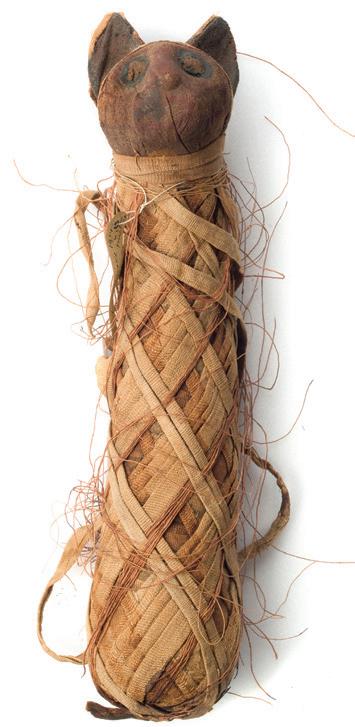
CHAPTER 9 ANCIENT EGYPT 279OXFORD UNIVERSITY PRESS No part of this publication may be reproduced, stored in a retrieval system or transmitted in
form
any
DRAFT
Everyday life9.8
Learning intentions
By the end of this topic, you will be able to:
» descr ibe the key beliefs, values and practices associated with everyday life in ancient Egypt.
Ancient Egypt was a highly organised civilisation that was deeply influenced by its people’s beliefs, values and practices. This influence was evident in various aspects of the ancient Egyptians’ daily lives.

Marriage, love and birth
Egyptians married as teenagers. Marriage was usually a business matter, arranged by the parents when the partners were young. This is why a man might, for example, marry his sister – to keep the money in the family. It seems not much fuss was made about weddings – the woman simply left home to live with her new husband. Yet marriage was seen (by law and religious belief) as a serious commitment and, as Source 4 indicates, some marriages would also have involved mutual love and respect apart from economic arrangement.
Source 5 These musical instr uments, known as sistra, made a loud clanging sound when shaken as the moving metal parts banged into each other.
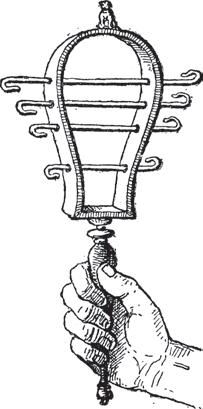
Childbirth was a risky business. There was a high loss of life for both babies and mothers. Some women gave birth in special ‘birthing houses’ in temples. People often called on deities for help. For example, they might ask for support from Hathor, the goddess of women (represented as a cow). Or they would ask Ra, the main Egyptian deity, to send a wind to cool the mother.
Music and dance
Source 4 This sculpture comes from the tomb of a couple buried together at Saqqara, near Cairo. The level of affection shown here (the woman’s arm behind the man) is uncommon in Egyptian paintings and carvings.
The ancient Egyptians had a range of musical instruments, including harps, drums and sistra (see Source 5). Music and dance were always part of funerals. They were also seen as ways to communicate with deities such as Sekhmet. People who had done the wrong thing were very scared of this goddess, because they believed she would destroy the wicked. Dancing was a way to appeal to her mercy. The ancient Egyptians also believed that sistra both honoured the god Hathor and frightened off the desert god Set (the god of chaos).
Communication
Only around 1 per cent of people in ancient Egypt learnt to read and write. These people, almost always men, were highly respected. They were called scribes (see ‘Key groups in Egyptian society’, page 268).
280 OXFORD HUMANITIES AND SOCIAL SCIENCES 7 AUS TRALIAN CURRICULUM OXFORD UNIVERSITY PRESS No part of this publication may be reproduced, stored in a retrieval system or transmitted in any form or by any means. DRAFT
9C How did beliefs, values and practices influence ancient Egyptian lifestyles?
During the period of the Old Kingdom, the ancient Egyptians used hieroglyphs, which were a form of writing, or script. This script contained over 750 symbols. As time passed, the ancient Egyptians developed simpler scripts – the demotic and hieratic scripts. These could be written more quickly, and were used for everyday writing.
Health and hygiene
The ancient Egyptians valued cleanliness. The wealthy bathed often. Priests used to shave their entire bodies regularly, and wash up to four times a day, so that they were completely clean when performing their religious duties. Slaves, on the other hand, washed rarely and so could be smelly and sticky. Records describe how one pharaoh, Pepy II, used to surround himself with naked slaves who were smeared with honey, so that flies would annoy them instead of him.
Health problems
Despite Egyptians’ love of cleanliness, ancient Egypt was not a healthy place to live. Malnutrition was common, especially among the poor, and there were other problems. These included:
• mosquitoes that bred in the Nile, spreading diseases such as malaria, which causes flu-like symptoms including fever
• rubbish and human waste that were often dumped in the Nile and other canals, leading to diseases such as dysentery, which causes severe diarrhoea
• breathing in sand blown in from the deserts, which often led to a lung disease called silicosis
• fragments of rock left in flour from the stones used to grind the grain, which caused tooth damage and decay.
Medicine and healing
The ancient Egyptians discovered a lot about the human body through their practice of mummification. For example, they knew how to use hot knives during surgery to seal blood vessels in order to stop uncontrolled bleeding. However, healing and medicine also relied heavily on magic and the influence of the gods. Priests were often involved in medical treatments, reciting spells and performing magic rituals.
9.8 Check your learnin g
Retrieve
1 Identify the ways in which ancient Egyptians showed that they valued cleanliness and their physical appearance.
2 Why were scribes so highly valued?
3 Identif y the practice that advanced the knowledge of anatomy for the ancient Egyptians.
Comprehend
4 Describe the role of music and dance in the society of ancient Egypt.
hieroglyphs picture-like signs used in the original writing system of the ancient Egyptians demotic and hieratic both simplified systems of writing based on hieroglyphs; demotic was faster and easier to write

Source 6 Ancient Egyp tian hieroglyphs in the Temple of the Dead of Rameses III, Luxor
5 Explain why ancient Egyptians often suffered from each of the following: bacterial infections, bad teeth and silicosis.
6 Explain why women called on gods when giving birth in ancient Egypt. Apply
Quiz me! A quick quiz on everyday life in ancient Egypt any or by any means.
7 Over time, written forms of communication developed and changed in ancient Egypt. Propose (put forward) why these changes happened.
CHAPTER 9 ANCIENT EGYPT 281OXFORD UNIVERSITY PRESS No part of this publication may be reproduced, stored in a retrieval system or transmitted in
form
DRAFT
Learning intentions
By the end of this topic, you will be able to:
» descr ibe the key beliefs, values and practices associated with warfare in ancient Egypt.
Warfare
Ancient Egypt had a fairly peaceful early history, mainly because the physical features that surrounded ancient Egypt, such as mountains and deserts, acted as natural barriers against invasion. During the Old Kingdom, Egypt had only a small army. During the Middle and New Kingdoms, however, the army grew into a large, wellorganised group because the pharaoh’s rule was often threatened.
The army and the pharaoh’s military role
Ancient Egypt’s army was similar to a loosely organised police force. It had three main roles:
• to keep law and order
• to protect the pharaoh and his palace
• to guard borders.
One of the pharaoh’s main responsibilities was to protect the Egyptian people from attack. The pharaoh was considered to be a god, so he had to make his people believe that he was strong enough to protect them. This was one of the reasons why many pharaohs built huge statues of themselves.
The army included both foot soldiers (those who walked and fought on the ground) and charioteers (soldiers who drove and fought from horse-drawn chariots like the one shown in Source 7). Usually, there were two charioteers in each chariot. One man steered the horses and the other used the weapons (usually a bow and arrow, and a spear). It cost a lot of money to buy a chariot and horses, so only wealthy men could become charioteers. Successful charioteers were looked on as heroes.
Life of a soldier
Evidence from ancient Egyptian sources shows that army life was tough. Soldiers had to participate in a very challenging program of weapons training and physical exercise. Soldiers who did anything wrong might be whipped. Often, soldiers had to go on long marches through the desert.
Source 7 The remains of a wall p ainting showing Pharaoh Rameses II charging into battle; the horse-drawn chariot was an important weapon in ancient Egypt. system transmitted in any form or by any means.
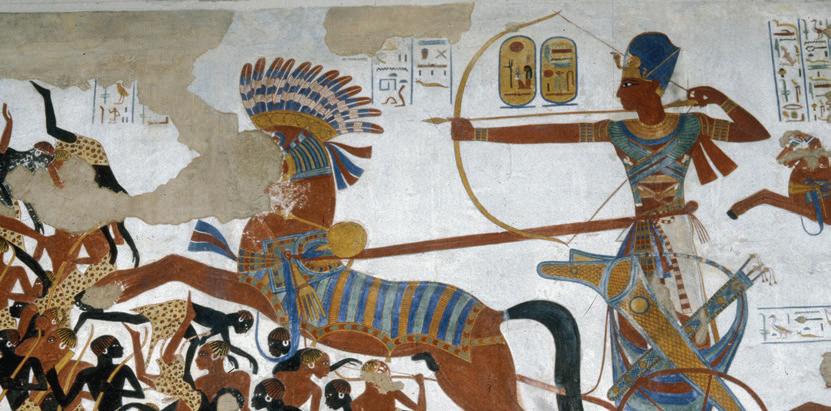
9.9
282 OXFORD HUMANITIES AND SOCIAL SCIENCES 7 AUS TRALIAN CURRICULUM OXFORD UNIVERSITY PRESS No part of this publication may be reproduced, stored in a retrieval
or
DRAFT
9C How did beliefs, values and practices influence ancient Egyptian lifestyles?
Treatment of enemies
Ancient Egyptians could be very harsh in their treatment of enemies they fought and conquered. There are accounts of corpses being destroyed, with body parts such as arms and heads chopped off to present to the pharaoh or the gods. But there were also many occasions of mercy. For example, conquered leaders were sometimes allowed to continue to rule their local region as long as they acknowledged the pharaoh as supreme ruler.
Weapons and armour
Soldiers did not wear much clothing, mainly because of the heat. They would usually wear a belt and loincloth, or a short tunic. They did not wear headgear. Some charioteers wore a type of armour on their upper body, made from leather straps. It seems that only the pharaohs wore metal armour, but not all the time. This armour was made from overlapping bronze pieces. Pharaohs would also wear a special headpiece during battle, known as the khepresh or blue crown. It was usually made of cloth or leather stained blue and covered with small gold or bronze discs (see Source 7).
Many weapons also served as farming tools. For example, axes might chop down palm trees as well as enemy bodies. Spears might kill creatures such as lions as well as men. Throwing sticks were useful for hunting birds. Many weapons, such as the mace, had religious importance. Archaeologists have often found weapons in graves alongside the remains of ancient Egyptian bodies.
9.9 Check your learnin g
Weapons used in ancient Egypt
Swords and daggers (made of bronze, and later iron)
Spears Bows and arrows
Shields Battleaxes Maces (heavy clubs with stone or copper ‘heads’)
Battering rams and scaling ladders (for attacking buildings with high walls)
Source 9 Some weapons used by soldiers in ancient Egypt
khepresh a blue crown often worn by the Egyptian pharaoh when in battle; it was often studded with semiprecious stones to create a hard surface
Retrieve
1 The army of ancient Egypt had two main types of soldiers. Identify them and describe how they fought.
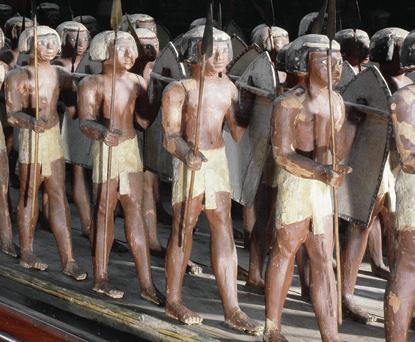
Comprehend
2 Write a short paragraph to describe what life was like for a soldier.
Analyse
3 Infer why the Old Kingdom of ancient Egypt only needed a small army. Apply
4 After some battles, ancient Egyptian soldiers cut off parts of people they had killed in battle and presented them to the pharaoh or as offerings to the gods. Propose (put forward) two reasons why you think they might have done this.
5 With a partner, create a role play between two soldiers who are discussing what life is like in the army – both in training and in battle.
Analyse this! Weapons and armour in ancient Egypt or by any means.
Source 8 A model o f Egyptian foot soldiers from the tomb of Mesehiti, an important official in Egypt during the 11th Dynasty (c 2134 −1991 bce)
Flint and bronze knives
CHAPTER 9 ANCIENT EGYPT 283OXFORD UNIVERSITY PRESS No part of this publication may be reproduced, stored in a retrieval system or transmitted in any form
DRAFT
Death and funeral customs9.10
Learning intentions
By the end of this topic, you will be able to:
» descr ibe the key beliefs, values and practices associated with death and funerary customs in ancient Egypt.
Religion played a major part in the life and death of ancient Egyptians. For those who were considered worthy, death was not seen as the end. Instead it was regarded as the start of a different sort of existence. To be worthy, each person had to live a good life.
In addition to living a good and honest life, there were a number of rituals that needed to be performed to ensure a smooth journey into the afterlife. These included:
• preserving the body after death through a process known as mummification
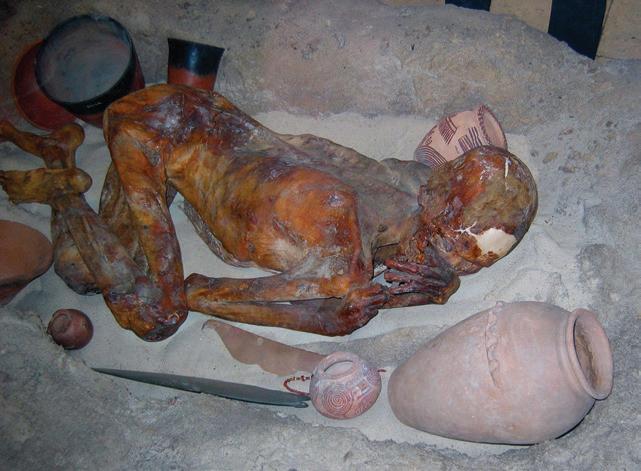
• reciting certain magic spells to ensure the person’s safe passage into the afterlife
• making sure that the dead person had access to what he or she would need in the afterlife. These items needed to be placed in the person’s tomb.
Journey to the afterlife
Once a person’s body was ready for burial, a procession including family, priests and professional mourners would take the body to its tomb. At the entrance of the tomb, the priests performed various rituals, including the ‘opening of the mouth’ ceremony.
sarcophagus the outer case (usually stone) of the nest of coffins containing the dead body of a person of importance
A priest touched all the head openings of the mummified body with an axe-like tool. This was believed to awaken the dead person’s senses. The coffin was then sealed up and placed in the stone sarcophagus. The dead person was now ready to start the journey into the afterlife.
The Book of the Dead
In order to reach the afterlife, the ancient Egyptians believed that the dead person would need magic spells and special prayers to support them through any dangers and further rituals on their journey. These spells and prayers were recorded in a special text known as the Book of the Dead. A copy of the Book of the Dead was often buried with the dead person.
One of the important rituals the dead person must undergo before being allowed into the afterlife was the ‘weighing of the heart’. In ancient Egypt, it was believed that the heart contained the soul, so the weighing of the heart was a kind of final judgement. The ritual is explained in Source 11.
Tombs
The earliest tombs were often graves in the desert. The hot, dry sand soon sucked all moisture from the corpse, preserving it. The poor continued to be buried this way even after burial practices had changed.
Source 10 This person was buried in a pit in the Egyptian desert 5400 years ago, along with some possessions. The well-preserved body had a number of broken bones.
284 OXFORD HUMANITIES AND SOCIAL SCIENCES 7 AUS TRALIAN CURRICULUM OXFORD UNIVERSITY PRESS No part of this publication may be reproduced, stored in a retrieval system or transmitted in any form or by any means. DRAFT
9C How did beliefs, values and practices influence ancient Egyptian lifestyles?
The first above-ground tombs were called mastabas. These were large, box-like structures. Many mastabas had detailed designs, with stones in patterns decorating the walls. Perhaps the best-known above-ground tombs were the pyramids. Today, more than 160 pyramids have been found.
When grave robbers started becoming a problem, tombs for important people such as pharaohs were dug underground in places such as the Valley of the Kings. This began to happen from about 1500 bce
Burial goods
Egyptians buried their dead with goods they believed would be needed in the afterlife – clothing, jewellery, pots, furniture, wigs, tools, chariots, boats, food and even servants! Later, small models of servants were used instead of the real servants.
Anubis, god of embalming and the dead, leads the dead person to judgment.
A row of judges sit watching.
Anubis weighs the dead person’s heart against a feather from the headdress of Ma’at, the goddess of truth and justice. If the heart is lighter than the feather, it means the person has led a good life and will be admitted to the afterlife.
Ammit, a female demon with the head of a crocodile, will eat the dead person’s heart if it is heavier than the feather.
Thoth, god of writing and knowledge, records the result of the weigh-in.
Horus, god of the sky and ruler of the world of the living, leads the dead person (who has passed the test) to Osiris.
Osiris, god of the dead and the underworld, allows the person into the afterlife.
Source 11 An ancient Egyptian painting showing the ‘weighing of the heart’ ritual
9.10 Check your learnin g
Retrieve
1 In your own words, define the following terms: a mastabas b pyramids.
Comprehend
2 Describe what the Book of the Dead was, including the role it played in Egyptian funeral customs.

3 Why was it so important to ancient Egyptians to preserve the body when someone died?
4 What role did climate and physical features have in ancient Egyptian burial practices?
Analyse
5 Analyse the connection between burial rituals and grave robbing in ancient Egypt.
6 Look at Source 11. Consider why ‘having a heavy heart’ might indicate that a person has not led a good life.
Apply
7 Discuss how religion influenced the burial and funerary customs of the ancient Egyptians. Look closely at the sources in this topic to help you.
Watch it! A video and quiz on the tomb in the Great Pyramid reproduced, stored in a retrieval system or transmitted in any form or by any means.
1 34 5 6 7 2
1 2 3 7 4 5 6
CHAPTER 9 ANCIENT EGYPT 285OXFORD UNIVERSITY PRESS No part of this publication may be
DRAFT
9.11 How mummies were made
Learning intentions
By the end of this topic, you will be able to:
» descr ibe the role of mummification in death and funerary customs.
To the ancient Egyptians, reaching the afterlife was a complicated business. It was not enough for a person simply to be worthy, they also had to be prepared for the journey according to a number of rituals, and be supplied with the necessary provisions and protections. Their bodies were preserved through the process of mummification (or embalming), which involved removing vital organs and placing charms and spells in specific areas (see Source 12).
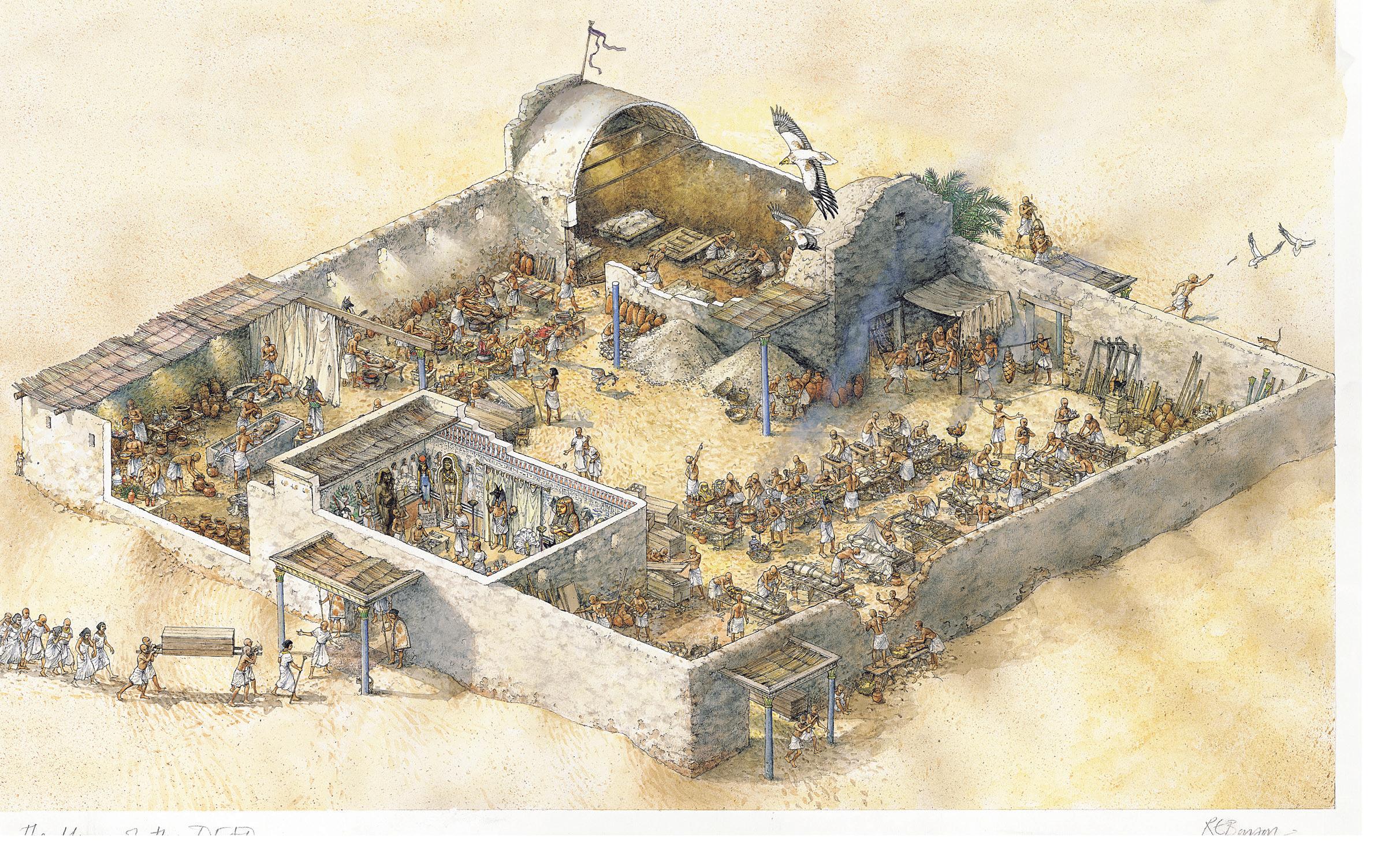
3
The liver, lungs, stomach and intestines are removed through a cut on the left side of the abdomen. A hook, pushed up through the nostrils, removes the brain (thought to be a useless organ that produces only mucus). The heart is left in the body.
44
The internal organs are dried in natron (a natural powder, a bit like salt), rubbed with fragrant oils and put into four canopic jars. Each jar’s lid is shaped like the head of a different god, who acts as the guardian of the organ within: the liver has a lid like a man’s head; the lungs, a baboon’s head; the stomach, a jackal’s head; and the intestines, a falcon’s head.
scarab a type of beetle considered sacred by the ancient Egyptians; the word ‘scarab’ also refers to items of stone or metal jewellery in the form of the scarab beetle resin a sticky substance (similar to the sap from a tree) used in ancient Egypt to glue bandages together
Source 12 The steps followed during the mummification process
2
The body is thoroughly washed. Prayers are read from the Book of the Dead by a priest.
1 The dead body is brought for mummification followed by mourners.
8 The mummy is put into a body-shaped coffin. Often more than one coffin is used, each one sitting inside the next. For important people like pharaohs, the nest of coffins is placed inside a stone box, called a sarcophagus.
286 OXFORD HUMANITIES AND SOCIAL SCIENCES 7 AUS TRALIAN CURRICULUM OXFORD UNIVERSITY PRESS No part of this publication may be reproduced, stored in a retrieval system or transmitted in any form or by any means. DRAFT
9C How did beliefs, values and practices influence ancient Egyptian lifestyles?
5 The body is then covered with salt for 70 days. This, and the dry air, sucks out any moisture. The body is washed again in water and smeared with fragrant oil.
6 Once the body has been embalmed, it is wrapped with rolls of fine linen (similar to bandages), starting with the head and neck. Toes and fingers are wrapped separately, and sometimes covered with gold caps. Sacred amulets such as the scarab are wound into the bandaging. During the wrapping, prayers from the Book of the Dead are said over the body.
I used to think, now I think
Reflect on your learning about the mummification process and complete the following sentences.
• I used to think …
7 The fully bandaged mummy is painted with sticky resin, and then more cloth is wrapped around it.
9.11 Check your learni ng
Retrieve
Sequence this! Making mummies
1 Identify why the brain was thought to be a useless organ. Comprehend
2 Describe what was done with a dead person’s internal organs during the mummification process.
3 Why were bodies covered with salt for 70 days?
4 Describe the religious ritual that was conducted as the bodies were wrapped in cloth.
Analyse
5 Examine the various elements illustrated in Source 12. What evidence does this source provide about ancient Egyptian beliefs and values?
• Now I think … What has changed in your understanding? retrieval system or transmitted in any form or by any means.

CHAPTER 9 ANCIENT EGYPT
287OXFORD UNIVERSITY PRESS No part of this publication may be reproduced, stored in a
DRAFT
SKILLS IN CONTEXT 9C The Great Pyramid at Giza
Test me!
Once you’ve finished the topics in this section, test yourself with this quiz and find out which worksheet you should do.


The Great Pyramid at Giza is the only remaining wonder of the ancient world. It was built in c. 2580 bce as the tomb of the Pharaoh Khufu. The pyramid was part of a bigger religious complex, which included a mortuary temple for the worship of the dead pharaohs.
The question of how the Great Pyramid was constructed with such accuracy has mystified many historians. They have come up with many different hypotheses about how it was built. Source 14 highlights the main steps that may have been used in the pyramid’s
Posts were buried deep in the slopes so blocks could be hauled from below.
The first step in the building of the pyramid was probably the selection of a workforce. It is believed that, during the inundation of the Nile, most of the workforce was made up of farmers who could not work on their farms because of the floodwaters.
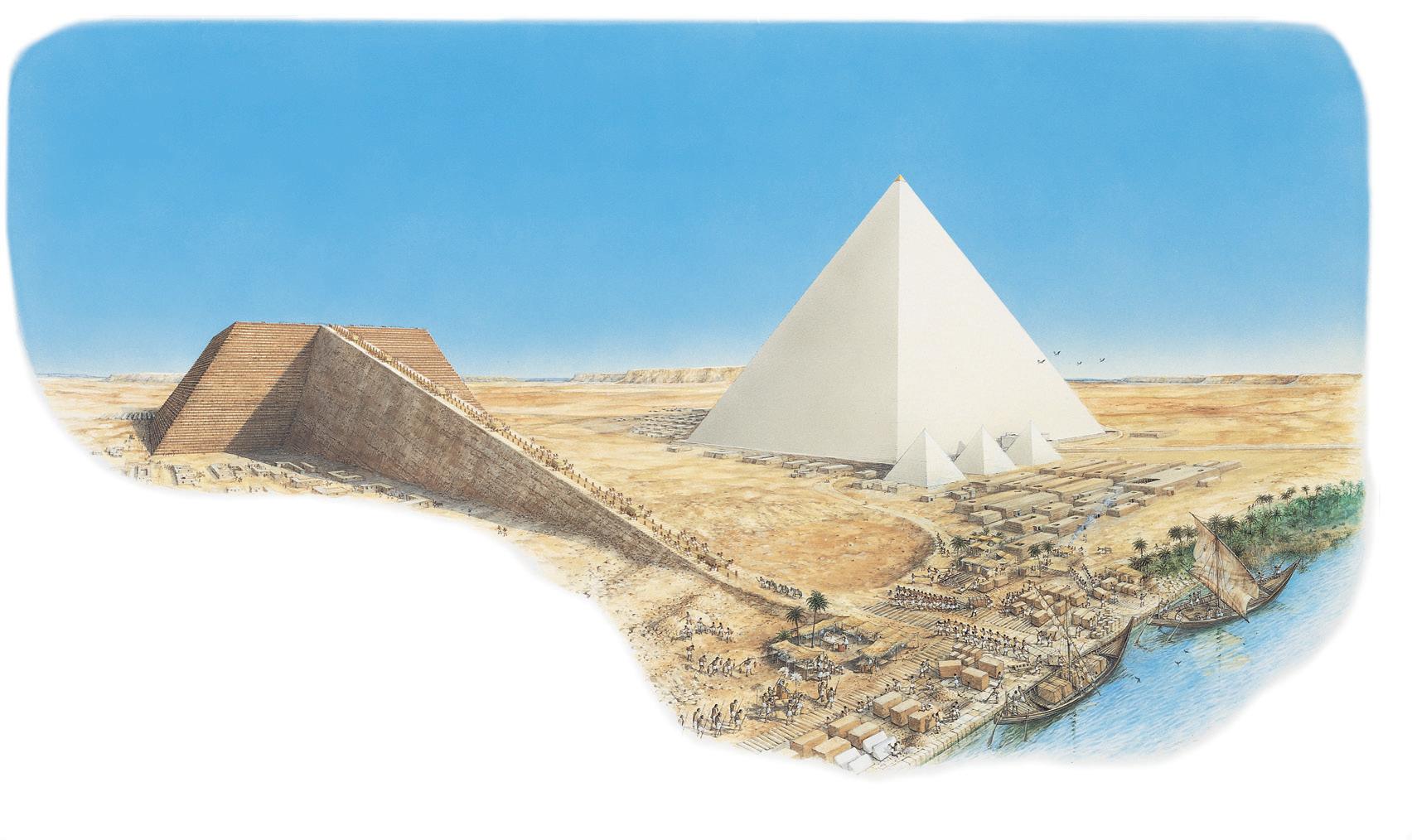

Once the first layer of blocks was laid, further blocks would then need to be dragged up to be placed on the next layer of the structure. There are many theories about how the blocks were moved but a discovery of a modified ramp in an ancient quarry suggests this technology could have been used at the time the Great Pyramid was built. The three-metre-wide ramp had steps either side of it. Set alongside the steps on each side were built-in holes which would have been filled with thick wooden posts. Teams of builders would then have wrapped ropes around the posts to create pulleys that allowed blocks to be pulled upwards from below and above. The slope of the ramp grew as the size of the pyramid did.
Source 14 Historians believe the building of the Great Pyramid at Giza took about 20 years and used more than 100 000 wor kers.
Scholars think that the blocks were probably dragged across wet sand on sleds to the base of the pyramid or, once construction started, to the bottom of the ramp. The sand in front of the sled was likely dampened with water to reduce friction, making it easier to move the sled.
Source 13 The Great Pyramid at Giza
OXFORD UNIVERSITY PRESSOXFORD HUMANITIES AND SOCIAL SCIENCES 7 AUSTR ALIAN CURRICULUM288 No part of this publication may be reproduced, stored in a retrieval system or transmitted in any form or by any means. DRAFT
construction. It is important to note that there is some debate about how the Great Pyramid was constructed. There are no surviving texts or manuals to tell us exactly how it was built.
Practise the skill
1 Look carefully at Source 14. Identify what the key steps would have been in the building of the Great Pyramid, and the order they would have been carried out. Create a flow chart that outlines these steps, using the guidelines above.
KEY SKILL Communicating

Creating a flow chart
After conducting their research, historians need to be able to express and communicate their findings in a range of ways and using different forms. Sometimes, historians communicate their findings orally or in writing. At other times, historians use particular graphic organisers, such as flow charts, to communicate information.
The final step in the construction of the pyramid of Giza was to place a pyramidion (a smaller pyramid cut from one piece of stone) on the very top. It was about 8 metres high and coated with a mix of gold and silver.
Once completed, each layer of the pyramid was coated with panels of white limestone.
The base of the Great Pyramid is almost flat. This has led many historians to believe that the area in which the Great Pyramid was to be built was first marked out and levelled. Marking out the ground involved complex mathematics. Precise calculations were required to set out where the corner blocks would be placed, the angle of the sloping sides, the height and the dead centre of the structure.
Flow charts are a very useful tool for communicating steps in a process. To create a flow chart, you need to think carefully about the steps involved in a process, as well as the order in which these steps would have been performed. A good flow chart should include:
• written descriptions of each step
• a small drawing or visual representation of each step
• arrows between each step to show the order in which they were performed.
For more information on this key skill, see page 213 of ‘The history toolkit’.
Extend your understanding
1 Source 14 shows one theory of how the Great Pyramid was built, but some historians still contest this theory.
a Investigate theories about how the pyramids were built. For example:

• a ramp that winds around the pyramid
• ramping systems inside the pyramids
• some of the blocks being made on the pyramid.
b Describe each theory and draw a simple picture to illustrate how it may have worked.
Most of the 2.3 million blocks used to build the Great Pyramid were limestone blocks, mined in local quarries. Others were heavy granite, found about 800 kilometres south in Aswan. They then had to be transported downriver on barges or ships.
c Which theory do you think is most likely to be correct? Justify (give reasons for) your answer.
9C How did beliefs, values and practices influence ancient Egyptian lifestyles?
CHAPTER 9 ANCIENT EGYPT 289OXFORD UNIVERSITY PRESS No part of this publication may be reproduced, stored in a retrieval system or transmitted in any form or by any means. DRAFT
Change through trade9.12
Learning intentions
By the end of this topic, you will be able to:
» explain the causes and effects of ancient Egypt’s contact and trade with other societies.
Ancient Egypt’s location offered it many advantages in terms of trade. For example, the Nile allowed merchants easy access to the Mediterranean Sea and beyond. The trade contacts they made with new markets helped Egypt to develop and prosper. So did the lands Egypt acquired through their military conquests during a period known as the New Kingdom.
There is evidence to suggest that Egyptian traders were making contact with other countries almost from the start of their history. There were early expeditions up and down the Nile, down the Red Sea and across the deserts.
Egypt had plenty of grain and dates, papyrus, flax (a plant used to make linen), stone, fish, oxen and salt. The ancient Egyptians bartered plentiful goods such as these for other goods that they had little of. Bartering was a way to exchange or swap goods without using money. For example, they would trade with their southern neighbour Nubia (modern-day northern Sudan), swapping their own supplies of grain for exotic goods such as ivory (elephant tusk) and ebony (a rare timber). They would also buy goods such as silver, iron, horses, copper, cattle, leopard skins and spices.
Source 2 An Egyp tian tomb painting showing Nubians carrying goods; some exchanges were ‘gift giving’ rather than trade. What was given reflected the power balance – a ruler who respected the power of Egypt might give ‘better’ (or more) goods than they received.
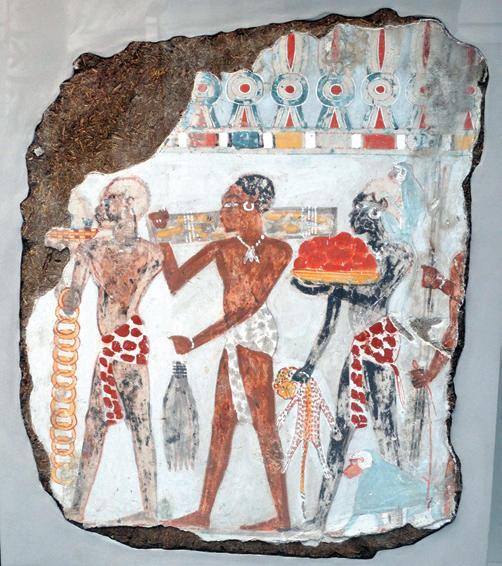
One of the more famous trade expeditions in ancient Egypt was when Queen Hatshepsut sent an expedition down the Red Sea, where they obtained trees, elephant tusks, gold, ebony, spices and foreign animals such as panthers. Sailors on the trading ships were paid in grain.
Egyptian traders would often travel on land with camel caravans through deserts. Alternatively, they would travel by boat or barge. TRALIANin retrieval system
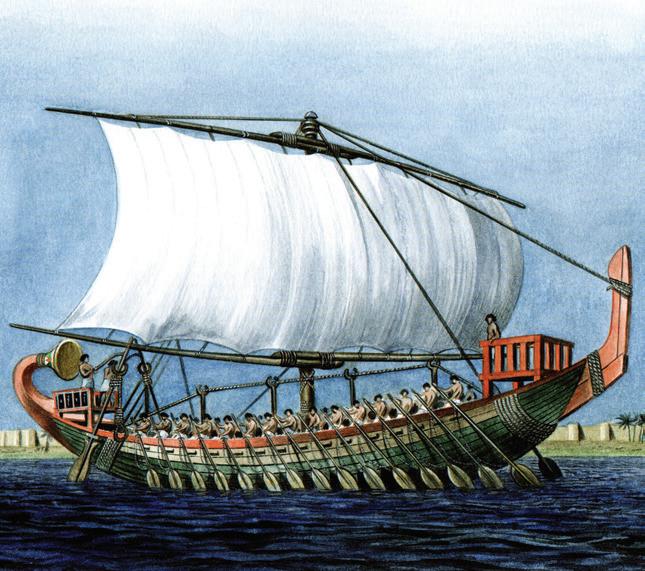 Source 1 An artist’s impression of an ancient Egyp tian river boat; Egyptian traders would have used boats like these to transport goods along the Nile.
Source 1 An artist’s impression of an ancient Egyp tian river boat; Egyptian traders would have used boats like these to transport goods along the Nile.
290 OXFORD HUMANITIES AND SOCIAL SCIENCES 7 AUS
CURRICULUM OXFORD UNIVERSITY PRESS No part of this publication may be reproduced, stored
a
or transmitted in any form or by any means. DRAFT
Retrieve
1 Identify the goods the ancient Egyptians had plenty of to trade.
2 In your own words, define the term ‘barter’. List the goods the ancient Egyptians bartered with the Nubians.
Comprehend
3 Look at Source 2. Identify the goods in this image you are familiar with. With a partner, try to work out what the other items might be.
4 Explain how the exchange of goods was sometimes a way to reinforce how rulers perceived the power of other countries.
Analyse
5 Examine Source 3 on this page. Using the world map at the back of this book, list the modern names of at least three countries that the ancient Egyptians traded with to obtain various goods. Apply
6 Create a concept map to show how imported goods listed in Source 3 might have helped to change the society of ancient Egypt.
7 Imagine that Australia is cut off from all contact with the rest of the world. As a class, discuss how you think this would influence our society in both the short term and the long term. What does your discussion reveal about the impact of trade on societies?
See, think, wonder
Look at Source 3.
• What do you see?
• What do you think?
• What do you wonder?
Quiz me! A quick quiz on change through trade in ancient Egypt
9D How did contacts and conflicts with other people change ancient Egypt? KEY TRADE ROUTES OF ANCIENT EGYPTIANS 1 2 2 3 4 4 5 6 7 7 8 9 11 11 12 12 12 10 10 13 13 14 15 17 16 18 18 19 20 Red Sea Arabian Sea Black Sea Caspian Sea PersianGulf Mediterranean Sea CRETE CYPRUS ARABIA LIBYA NUBIA Memphis Byblos Thebes 1 Olive oil Commodities traded 2 Cattle 3 Silver 4 Copper 5 Mineral powders (for eye make-up) 6 Horses 7 Camels 8 Monkeys and baboons 9 Ostrich eggs and feathers 10 Exotic woods (e.g. frankincense) 11 Stone 12 Semiprecious stones 13 Gold 14 Cedarwood 15 Iron 16 Lapis lazuli (blue mineral used in jewellery) 17 Turquoise 18 Ivory 19 Chickens 20 Incense Trading route LEGEND 0 350 700 km Source 3 Source: Oxford University Press 9.12 Check your learnin g
CHAPTER 9 ANCIENT EGYPT 291OXFORD UNIVERSITY PRESS No part of this publication may be reproduced, stored in a retrieval system or transmitted in any form or by any means. DRAFT
Learning intentions end of this






Change through conflict
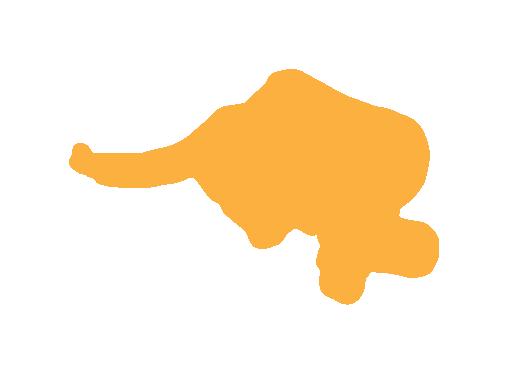

At the start of the New Kingdom in 1550 bce, Egypt’s army was more professional than it had ever been. Its soldiers had better military equipment and were better trained. This put Egypt in a strong position to conquer territories beyond its borders.
The pharaoh Thutmose III and his army were particularly successful at this. Their efforts meant that a large part of southern Syria was brought under Egypt’s control.
A growing threat to Egypt around this time were the Hittites. The Hittites were a group of people keen to build their empire. From about the fourteenth century bce, the Hittites started to push south from the area that is today known as Turkey, down through the coastal regions of the western Mediterranean Sea. Egypt had maintained
Campaigns of Seti I and Rameses II

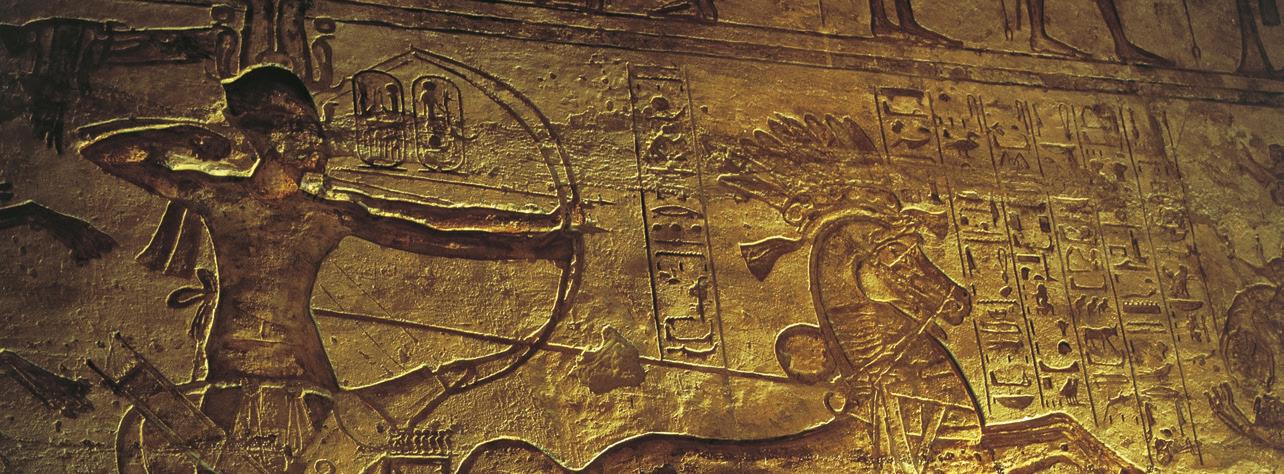
The 19th Dynasty pharaoh Seti I used Egypt’s growing military strength to further expand Egypt’s influence. He fought conflicts in Canaan, Syria, Libya and Nubia in an attempt to increase Egypt’s power and prestige.
Kadesh was a city in Syria that had been taken from the Egyptians by the Hittites. Seti I led a very bloody battle against the Hittites and was able to reclaim Kadesh for a short time.
Rameses II became the pharaoh after his father, Seti I. He was in power for a long time, from c. 1279 to 1213 bce. Under his rule, Egypt’s economy boomed. Rameses was also a remarkable soldier, and he was determined that Egypt would take over Kadesh permanently.
Source 5 Rameses II celebrated what he claimed to be a great victory at Kadesh with many texts and stone artworks. This stone carving at the Abu Simbel temple shows him on the attack.
9.13
By the
topic, you will be able to: » explain the causes and effects of the rise of the Egyptian Empire » understand the significance of Black Sea Dead Sea Orontes River Euphrates R Arabian Desert EGYPT CANAAN SYRIA Kadesh Red Sea Mediterranean Sea 0 400 km N 039920_SAL_BAH1 8-3-11 Egypt and Hittite empires Extent of Hittite Empire at the time of Rameses II Area ruled by Egypt under Rameses II Nation of Amurru LEGEND EGYPT’S TERRITORIAL EXPANSION DURING THE NEW KINGDOM Source 4 Source: Oxford University Press
OXFORD UNIVERSITY PRESS292 OXFORD HUMANITIES AND SOCIAL SCIENCES 7 AUSTR ALIAN CURRICULUMNo part of this publication may be reproduced, stored in a retrieval system or transmitted in any form or by any means. DRAFT
9D How did contacts and conflicts with other people change ancient Egypt?
The Battle of Kadesh
The Battle of Kadesh (1274 bce) is thought to be the biggest chariot battle in history. It is also the first battle in history where there are records from both sides, and it led to the world’s first peace treaty. For all these reasons, the Battle of Kadesh is seen as historically significant.
The Battle of Kadesh
The ancient city of Kadesh lay on the trade route that linked the Mediterranean Sea to the northern part of ancient Syria. Egypt lost its influence over Kadesh to the Hittites during the time that the pharaoh Akhenaten was in power (around the mid-fourteenth century bce). The main reason for the battle was that Egypt wanted Kadesh back. Amurru, a nation near Kadesh, had also been taken over by the Hittites. The battle was started because Amurru asked for help from Rameses II to free itself from Hittite rule.
In the end, neither side actually won, although Rameses tried to say that he was the victor for some time. The longer-term effect of this battle was the historic treaty that Egypt signed with the Hittites in 1269 bce The treaty set out their agreement that Egypt would not invade Hittite territory and the Hittites would not
invade Egyptian territory. The effect of this treaty was that there were 70 years of peace for the region.
For more information on this key concept, see page 192 of ‘The history toolkit’.
KEY CONCEPT Cause & effect
Source 6 This tomb paint ing shows Rameses II at the Battle of Kadesh. It is only one of a great many monuments and paintings he had made as propaganda for his achievements.
Quiz me!
9.13 Check your learni ng
Retrieve
1 Identify what started the Battle of Kadesh. Comprehend
2 Explain the importance of Kadesh. Why was it so important to Rameses II?
3 Describe why the Battle of Kadesh was so historically significant.
Analyse
4 Examine Source 6. Given what you know about Rameses II and the Battle of Kadesh, explain why this tomb painting is a good example of propaganda. How do you think the Hittites might have reacted to this?

Apply
A quick quiz about change through conflict stored in retrieval system or transmitted in any form or by any means.
5 Propose (put forward) reasons why Rameses II tried to say that he was the victor in the Battle of Kadesh. To help answer this question, think about what you know of the role of the pharaoh in ancient Egypt.
CHAPTER 9 ANCIENT EGYPT 293OXFORD UNIVERSITY PRESS No part of this publication may be reproduced,
a
DRAFT
SKILLS IN CONTEXT The Battle of Kadesh9D
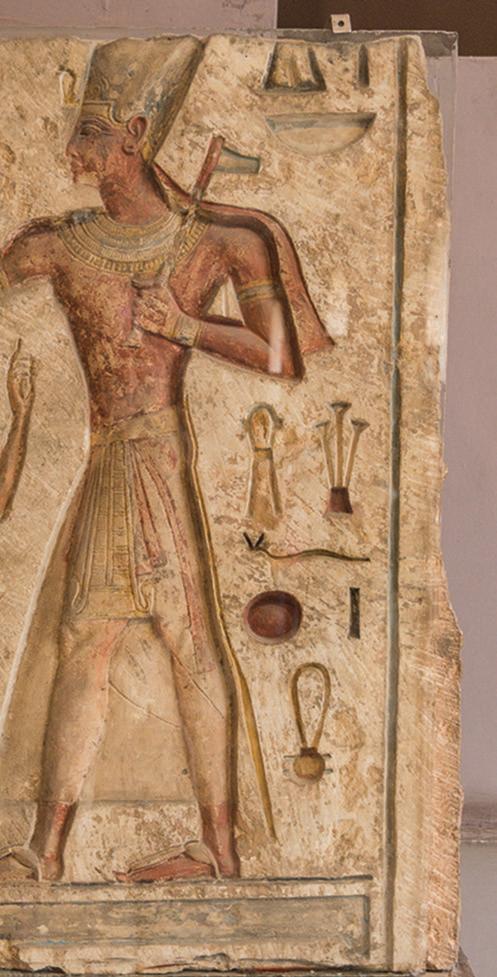
In this battle, the Egyptian pharaoh Rameses II and his army fought the Hittites to regain control over the ancient city of Kadesh.
Test me!
Once you’ve finished the topics in this section, test yourself with this quiz and find out which worksheet you should do.
Rameses II’s plan of attack was to divide his troops into four groups or ‘divisions’: Amun, Re, Ptah and Seth. Each group would march from their starting point in the forest, north through the desert into Kadesh, one day apart, in the order mentioned. Rameses II led one of the groups – the Amun. They set up camp in a swampy area south of Kadesh.
Two Hittite spies told Rameses II that the Hittites were far away, so Rameses II was very confident that he and his army would be able to take Kadesh.
Unknown to him, the Hittite army was hidden and waiting. While the Amun group camped near the swamp, the Hittites sneaked out and attacked the Re group, killing nearly all of them. Then, the Hittites turned north to finish off the Amun group. Luckily for Rameses II, the Ptah group arrived to help the Amun group at the scene of battle. It was a tough battle and Rameses II was forced to fight for his life.
 Source 7 A stone carving of the Battle of Kadesh showing the army of pharaoh Rameses II fighting Hittite soldiers.
Source 7 A stone carving of the Battle of Kadesh showing the army of pharaoh Rameses II fighting Hittite soldiers.
294 OXFORD HUMANITIES AND SOCIAL SCIENCES 7 AUS TRALIAN CURRICULUM OXFORD UNIVERSITY PRESS No part of this publication may be reproduced, stored in a retrieval system or transmitted in any form or by any means. DRAFT
Creating a visual representation of a historical event
Historians often use information in a written secondary source to create a visual representation of the key ideas or events. This representation might be a map or a labelled diagram. The process of creating such a representation can be very helpful for forming a better understanding or building a clearer picture of events. The resulting visual representation also makes it easier to explain events to others. The following steps will help you to create a good visual representation of a historical event:
Practise the skill
1 Copy the maps in Source 8 into your notebook and use them to create a visual representation of how the Battle of Kadesh unfolded. The first one has been done for you. Do not forget to complete the legend.
Extend your understanding
1 Explain how Rameses II might have reduced his troop losses to help him win the battle.
Step 1 Read the information in the source carefully.
Step 2 Identify the key players mentioned in the source.
Step 3 Re-read the information, this time making sure you visualise each stage of the events being described.
Step 4 Choose symbols and colours to represent key players, locations and events; for example, you might use arrows to show movement.
Step 5 Include a legend to explain the symbols and colours used in your representation. For more information on this key skill, see page 198 of ‘The history toolkit’.
2 Discuss how the propaganda about the godlike achievements of Rameses II would have been received in Egypt. How do you think it influenced the perceptions of ordinary Egyptians?
3 Write a poem about the battle from the point of view of Rameses II.
4 Design a stone relief or wall painting to commemorate the Battle of Kadesh. The design can be from a neutral perspective, or from the perspective of Rameses II or the Hittites.
Kadesh
HOW THE BATTLE OF KADESH UNFOLDED
Kadesh PTAH
9D How did contacts and conflicts with other people change ancient Egypt?
AMUN RE PTAH Kadesh Kadesh Kadesh
Source 8
AMUN RE
Kadesh Kadesh Kadesh LEGEND KEY SKILL Communicating CHAPTER 9 ANCIENT EGYPT 295OXFORD UNIVERSITY PRESS No part of this publication may be reproduced, stored in a retrieval system or transmitted in any form or by any means. DRAFT
Review activity
Examine both sources carefully and answer the questions below.
Source 10
The famous scene from Djehutihotep's tomb illustrates well the reasons why the ancient Egyptians were so successful in manoeuvring and building such impressive monuments, which were accomplished by the combination of knowledge, skill and necessary man-power, the latter provided by a willing workforce drafted in especially for the task rather than an army of slaves so often portrayed in books and films …
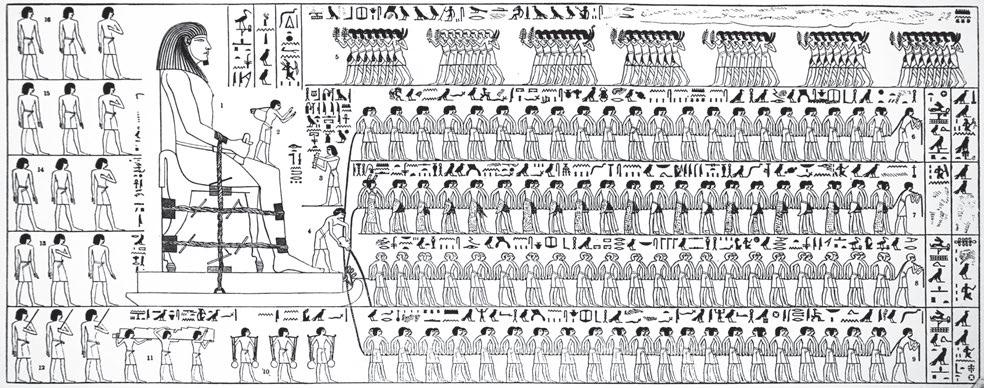
The colossus has been placed on a wooden sledge for transportation … The hauliers are gliding the sledge over a layer of carefully prepared sand, and there is some speculation about the significance of the man pouring water in front of the sledge: he was originally thought to be offering a libation (a drink poured out as an offering to a deity) as part of a ceremony, but it has been recently proposed that the ancient Egyptians understood that if a certain amount of water is added to sand, it significantly reduces the amount of friction generated by the dragging of such heavy loads.
An analysis of Source 9, provided by The Griffith Institute
1 Identify the role of Djehutihotep in ancient Egyptian society. (1 mark)

2 Determine (decide) whether the sources provided are primary or secondary sources. Give reasons for your answer. (3 marks)
3 a Explain the significance of the man pouring water in front of the sledge. b What was it previously thought that the man was doing? (4 marks)
4 As you have learned, every source is created from a different perspective. Read Source 10 and identify some of the words that the author has used that indicate their perspective on the ancient Egyptians’ construction skills. (2 marks)
5 Evaluate the construction abilities of the ancient Egyptians, using both sources to help you. (10 marks)
(Total: 20 marks)
 Source 9 Wall painting from the tomb of Djehutihotep, who was a government official during the 12th Dynasty, c.1900 bce CHAPTER REVIEW
Source 9 Wall painting from the tomb of Djehutihotep, who was a government official during the 12th Dynasty, c.1900 bce CHAPTER REVIEW
9
296 OXFORD HUMANITIES AND SOCIAL SCIENCES 7 AUSTR ALIAN CURRICULUM OXFORD UNIVERSITY PRESS No part of this publication may be reproduced, stored in a retrieval system or transmitted in any form or by any means. DRAFT
Chapter checklist
Now that you have completed this chapter, reflect on your ability to do the following:
Explain how the physical features of ancient Egypt influenced its development.
Explain how the climate of ancient Egypt influenced its development.
Explain the social structure and role of key groups in ancient Egypt. Describe the rights and responsibilities of women of different classes.
Explain the role of pharaohs in the social structure of ancient Egypt.
Describe the historical context, life and achievements of Tutankhamun.
Describe the key beliefs, values and practices associated with religion in ancient Egypt.
Describe the key beliefs, values and practices associated with everyday life in ancient Egypt.
Describe the key beliefs, values and practices associated with warfare in ancient Egypt.
Describe the key beliefs, values and practices associated with death and funerary customs in ancient Egypt.
Describe the role of mummification in death and funerary customs.
Explain the causes and effects of ancient Egypt’s contact and trade with other societies.
Explain the causes and effects of the rise of the Egyptian Empire. Understand the significance of Rameses II.

Go back to Topic 9.2, page XXX.
Go back to Topic 9.3, page XXX.
Go back to Topic 9.4, page XXX.
Go back to Topic 9.5, page XXX.
Go back to Topic 9.6, page XXX.
Go back to Topic 9.7, page XXX.
Go back to Topic 9.8, page XXX.
Go back to Topic 9.9, page XXX.
Go back to Topic 9.10, page XXX.
Go back to Topic 9.11, page XXX.
Go back to Topic 9.12, page XXX.
Go back to Topic 9.13, page XXX. Play a game of Quizlet Ancient Egypt.
I can do this. I cannot do this yet.
Check your Student obook pro for these digital resources and more: Student book questions Chapter 9 Key skill worksheet Communicating: Chapter 9
on
Chapter review quiz Chapter 9 CHAPTER 9 ANCIENT EGYPT 297OXFORD UNIVERSITY PRESS No part of this publication may be reproduced, stored in a retrieval system or transmitted in any form or by any means. DRAFT
Northern Territory
Adam Jovanou
State
E:
M:
Western Australia
Adam Jovanou
State Sales Manager WA | SA | NT
E: adam.jovanou@oup.com
M: 0437 997 146
Renee Kennedy
Secondary
E:
M:
Victoria
John
State
Caitlin
Secondary Education Consultant
E: paul.mccallum@oup.com
M: 0423 241 455
Tasmania David Griffiths Secondary Education Consultant
E: david.griffiths@oup.com
M: 0427 225 891
Our
To
Queensland
John Figliano
State Sales Manager QLD
E: john.figliano@oup.com
M: 0499 114 429
Chris Lowcock
Secondary Education Consultant
E: christopher.lowcock@oup.com
M: 0428 949 935
Melissa Wearne
Secondary Education Consultant
E: melissa.wearne@oup.com
M: 0447 557 931
New South Wales
Catherine Stephenson
State Sales Manager NSW | ACT
E: catherine.stephenson@oup.com
M: 0404 021 237
Sue Dowd
Secondary Education Consultant
E: sue.dowd@oup.com
M: 0411 759 608
Caly James
Secondary Education Consultant
E: caly.james@oup.com
M: 0413 745 855
Australian Capital Territory
Caly James
Secondary Education Consultant
E: caly.james@oup.com
M: 0413 745 855
Contact us For more information about this series please contact a Secondary Education Consultant in your state or territory:
Privacy Policy sets out how Oxford University Press handles your personal information, and your rights to object to your personal information being used for marketing to you or being processed as part of our business activities.
view our Privacy Policy go to oup.com.au/privacy oup.com.au @OxfordAustralia facebook.com/oupanz linkedin.com/showcase/oxforduniversity-press-australia-new-zealand Visit us at oup.com.au or contact customer support at oup.com.au/help
Sales Manager WA | SA | NT
adam.jovanou@oup.com
0437 997 146
Education Consultant
renee.kennedy@oup.com
0418 857 546 South Australia
Purnell
Sales Manager VIC E: john.purnell@oup.com M: 0403 043 584 Alicia Giaquinta Secondary Education Consultant E: alicia.giaquinta@oup.com M: 0411 759 611 David Griffiths Secondary Education Consultant E: david.griffiths@oup.com M: 0427 225 891
Hansford Secondary Education Consultant E: caitlin.hansford@oup.com M: 0411 759 659 Paul McCallum
No part of this publication may be reproduced, stored in a retrieval system or transmitted in any form or by any means. DRAFT
